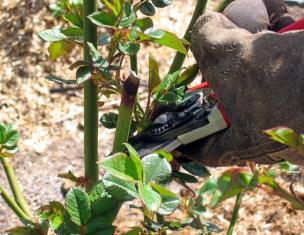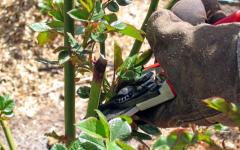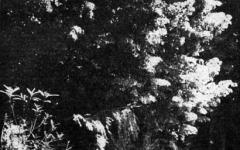st. Bolshaya Tulskaya, 2
This 14-storey residential building is popularly referred to as the “ship-house” or “titanic”. Built in 1981 in the brutalist style, this panel building stood out against the background of the old low-rise buildings of the area. With its impressive dimensions (400 m long and over 50 m high), as well as the upper rows of glazed balconies, it looked like a cruise liner. By the way, on the upper floors there are two-story apartments, which were conceived as elite.
Sirinda will stay here until her family is ready to fire him, both emotionally and financially. His body will one day leave family home with an unimaginably magnificent funeral, after a great procession through the city. The Buffalo is supposed to carry the soul to the outpost, and so many of these animals are sacrificed by families to ease the journey for the dead.
Those who sacrificed many buffaloes will come faster and easier. Others will come later and more difficult. Torai spend most of their lives in these rituals. When families manage to save enough money, they invite all their friends and relatives around the world.
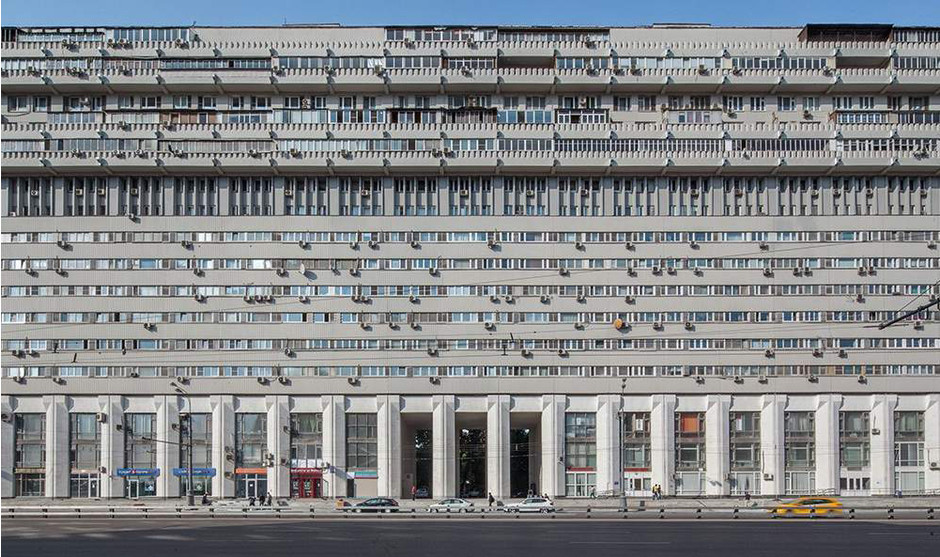
"Unlike my father's funeral"
The richer the dead were when he was alive, the more and more complex the ceremonies. His funeral lasted four days, during which 24 buffalo and hundreds of pigs were sacrificed in his honor. Subsequently, the meat was distributed among the guests to celebrate Dengen's life and next reincarnation.
For him, we held a small ceremony with the next of kin in a small, dark and quiet place. This is an extraordinary contrast to what Dengen's family will remember about his funeral. After the funeral, it was time to bury the dead. They place their dead in familiar tombs or inside caves, as there are many of them in this mountainous region. These caves are another place where life after death seems to be connected to this existence.
The construction was carried out by order of the Ministry of Atomic Industry of the USSR. Hence - another name for this Moscow house - "the house of nuclear scientists", as well as the unique strength of concrete walls, not inferior to Soviet nuclear reactors.
![]()
They contain countless coffins and bodies, and even skulls and bones. Friends and family cover the "basic needs" of their deceased and often bring them money and cigarettes. In a tradition that arose before photography, images dead people and noble women are carefully carved in the forest.
These sculptures, known as tau-tau, wear the clothes, jewelry, and even hair of a dead person, as well as silent guardians who look out at this world from another plane. But burial doesn't mean goodbye. The physical connection between the dead and the living continues much later through a ritual called maenena or "cleansing of bodies".
Krivoarbatskiy per., 6
The house-workshop of the architect Konstantin Melnikov is called the "icon of constructivism" and is compared in importance for Russian culture with Kizhi and St. Basil's Cathedral. In 1927, the brilliant architect designed the "eight" of cylinders embedded into each other, creating in the center of Moscow not just a residential building for himself and his family, but a space that was not like it in the world. A house built without load-bearing supports and beam floors, survived the explosion of a high-explosive bomb, was restored after the war and entered into all textbooks on architecture.
Every two years families take the coffin of their dead from the graves, open them and have a great reunion. In the first ceremonies, friends and family offer food and cigars to the dead and carefully cleanse and care for their bodies. Then borrow them for family portraits.
Songs mixed with the sound of crying women create a surreal atmosphere. They are all here for the ceremony of Maria Solo, who died three years ago, stating she is now 93 years old and placed in this family grave a year ago. Now it's time to get out.
The men take off the red and cylindrical box, decorated with geometric designs in shades of gold and silver. Close relatives of Mary's coffin donations, including coca leaves, cigarettes, walnuts and buffalo ears. But before the opening of the coffin, one more ritual must be performed: the sacrifice of a buffalo.
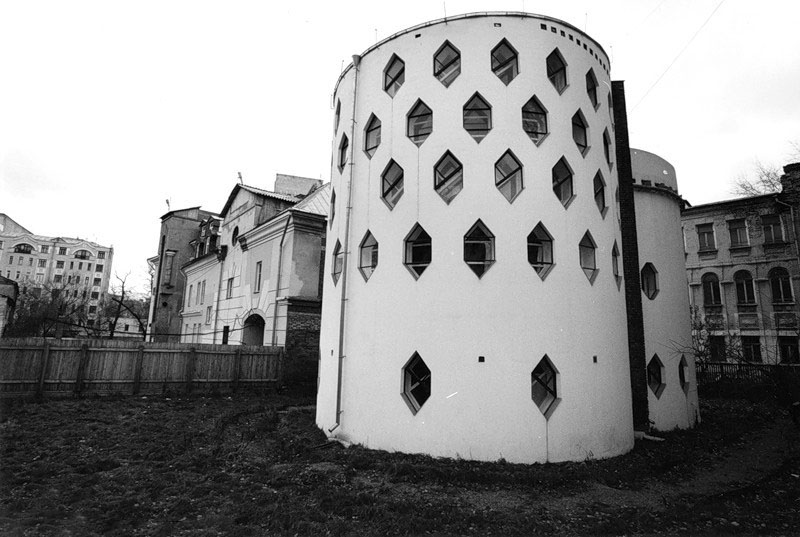
The relatives finally open the coffin, and once again the intense hazy smell of formalin invades the environment. The body of a small, old woman lies inside the coffin. His carefree white hair shows his delicate face. Her eyes and mouth are half open, and the gray tone of her skin makes her look more like a stone statue than a dead woman.
How do your children feel when they see their mother? His eldest son, a baseball cap-wearing entrepreneur living in the nation's capital Jakarta, seems very calm. It doesn't bother him at all to see his mother in this way, he tells me. On the contrary, it reminds him how much Mary endured and how much she loves her.
For simplicity and efficiency, it was called the house-beehive. Most recently, after long litigation and trials, the famous Melnikov house was opened to the public. The guests are introduced to the architectural features of the monument, they are shown branded hexagonal windows, a bedroom with Venetian plaster and a folding "centipede" for which the family of the world-famous architect gathered.
Like Sirinda's family, Maria's relatives still refer to her in the present tense, as if she had not died. Once the body is exposed, any signs of mourning or tension disappear. Another close relative Maria Solo is her sister-in-law, Esterbobon, who claims the girlish ritual adds weight to her mourning and helps her remember the lives of her loved ones.
However, Estersobon insists that this ritual does not affect how he remembers his loved ones. Once everyone in the family is spending time with Maria and taking pictures with her, it's time to wrap her body in a white cloth, a symbolic way to change her outfit.
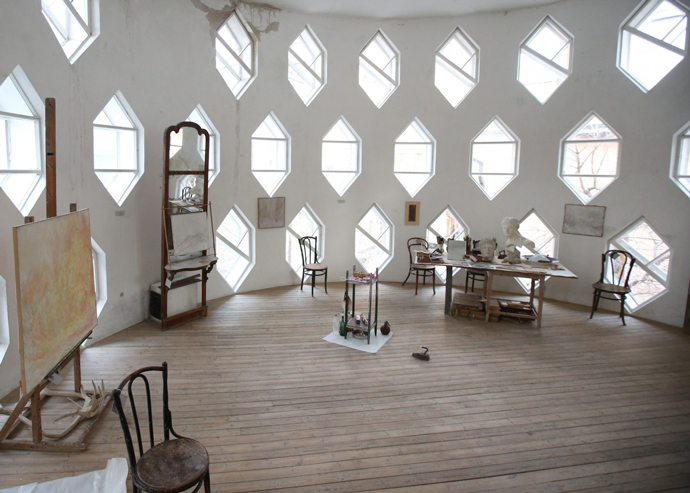
In some villages, they still completely change the clothes of the dead and even take their bodies for walks in the village. But these practices are gradually disappearing. Over 80% of Torai abandoned the old animistic religion known as Aluk dolo and converted to Christianity. And as a result, their rituals are also gradually changing.
However, Christianity and Aluk dolo traditions coexisted in this region for a long time. Andy Tandy Lolo notes that when missionaries from Holland arrived less than a century ago, they tried to ban animistic religions. But perhaps the principles underlying these rituals are not so different from those found in other cultures.
st. Running, 34
This house was built in 1978 according to the design of Andrey Meyerson as an experimental one. main feature buildings - twenty pairs of reinforced concrete "legs" -supports, thanks to which the house received the nicknames "house on legs", "centipede house", "octopus house" and "hut on chicken legs" among the people. These supports taper downwards, which creates the effect of "unreliability" of the structure. The house itself seems to be expanding upward - each of the next of the 13 floors overlaps the lower one. Three smoke-free oval stairwells became the main accents on the facade.
Remembering the dead is what many of us try to do in the best possible way. Toraja just remembers her loved ones differently. Though you have to blink a few times to make sure you didn't accidentally quit in the movie Labyrinth and you didn't chase a white rabbit with a clock to fall into a hole in Alice's tree in Wonderland. However, if you see a cat in the area, feel free to ask him between whispers and no one hears you if he knows how you should follow, because if he sneaks inside from time to time, it's not surprising if he answered .
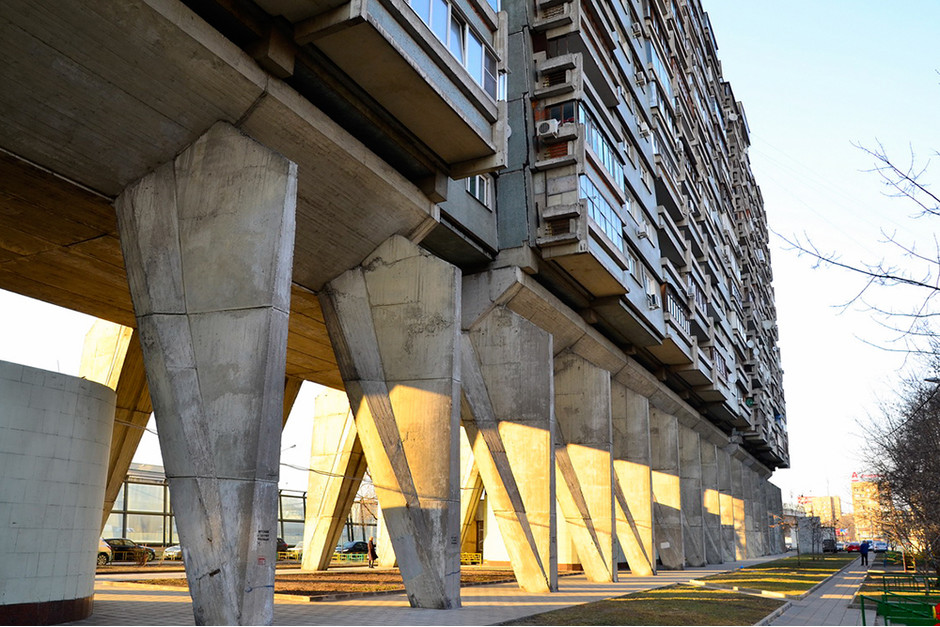
Art turned into nature
Dalat has a personality that is different from the rest of the country in several aspects, and it has certain rarities that almost all travelers make on their road map when they are about to cross it. This peculiar property is the work of Hang Hg and the daughter of a Vietnamese former president Truong Chin, Ho Chi Minh's own successor. This familiar situation already offers some clues as to how the architect got away with this project. Even being who he was, the works were interrupted several times, and this doctor in architecture had to "fight" for the construction of the work, which at some points crossed paths to go against the values of the regime.
When developing the project, Andrei Meyerson was inspired by the ideas of Le Corbusier: as a result, his “House on Legs” with its proportions and sloping supports resembles the Marseille “Housing Unit”. Initially, the house was conceived as a hotel for the participants of the Summer Olympic Games 1980 in Moscow, and as a result, the apartments in the new house went to the honored workers of the Znamya Truda plant, which produced Il-12, Il-14 and Il-18 aircraft. Hence another of its names - "House of Aviators".
In this case, his methods of persuasion have triumphed, and thanks to this we can now enjoy a building that has little or no relation to the rest of the architecture of the country. "Crazy House", in which the author has a room, is a mixture between dreams and nightmares. In addition to the hotel, it functions as an exhibition hall. Walking through it narrow corridors, up and down steep stairs that defy the laws of gravity and barely fit for a human bordering the sides, and where you are surrounded by views of both animal and plant life, is a spectacle in itself.
This is not the only "house on legs" in Moscow: similar ones can be seen at the following addresses: Prospekt Mira, 184/2 (opposite the monument "Worker and Collective Farm Girl"), Smolensky Boulevard, 6/8, house-commune on Ordzhonikidze Street, 8/9 .
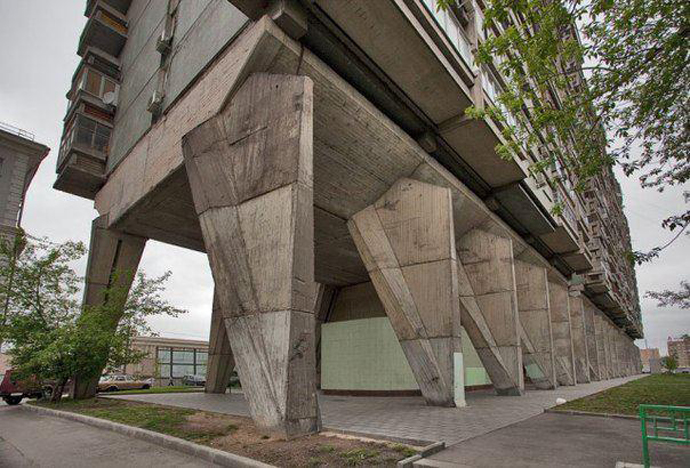
This was the ultimate goal of its creator when it was designed: to bring nature closer to the viewer. The feeling when walking is bitter. Sometimes he thinks of Tim Burton with stomach acidity or the product of a riot between Gaudí, Dali and Disneyland. The most curious thing is that when the author did the projects, he was not in any of the places they came up with.
It has a total of ten rooms, each inspired by various types animals, the forest, the jungle, and even one that makes you feel like you're inside a Winnie the Pooh tree. In some, you could safely read for hours, while in the next room you feel like you are going out running, just urinate on the door and see the decoration with spiders waiting for you inside. It's funny how no one is sure that what he sees likes, or vice versa.
D. Ostrovtsy, 14th km of Novoryazanskoye Highway
Very close to Moscow, in the village of Ostrovtsy (Ramensky district), for several years now, a very unusual house has attracted the attention of all those passing by.
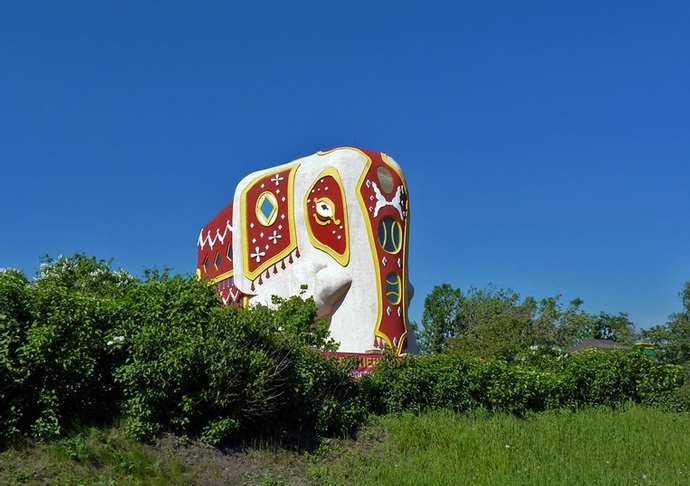
The lunatic asylum is another curious construction that, like it, does not go unnoticed in the eyes of both those who live in the city and those who walk. Travel claims that were not born with this vocation. The work of dreamers who decided to do things differently with everything around them.
The history of man stands out for its architectural abilities and the creation of structures that leave us open. Therefore, in today's article we will talk about the rarest designs in the world. He believes that some works of great glory, such as the Leaning Tower of Pisa, the Eiffel Tower, the Statue of Liberty, the Burj Khalifa, have their own history and strangeness.
The building was built in the form of an Indian elephant in a bright red blanket, decorated with small diamond-shaped windows and painted with rich colors. Inside there are four floors connected spiral staircase. The author and owner of the house Aleksey Sorokin is looking for buyers: “This is a domed huge room where you can realize any design fantasy. No walls, no support beams- nothing limits you.
Some of these curiosities are Pisa's pillar tower, a room hidden in the Eiffel Tower, or the height of the Burj Khalifa. However, it's worldwide famous buildings and places, as well as other classical monuments such as Chinese Wall or the Sagrada Familia. Fortunately, there are other buildings that deserve to be on the list of the rarest buildings and places in the world. In this section, we will tell you where to find and what such strange and curious sites look like.
The rarest structures in the world: strange and unstable, but safe places
The most curious and remarkable thing about this list of the rarest buildings in the world is that they seem to be unstable, but nothing less than a reality. They take years in perfect harmony with environment, and they stand out mainly for their originality and location, since they are located in environments and places of growth where it seems impossible that it can be built.
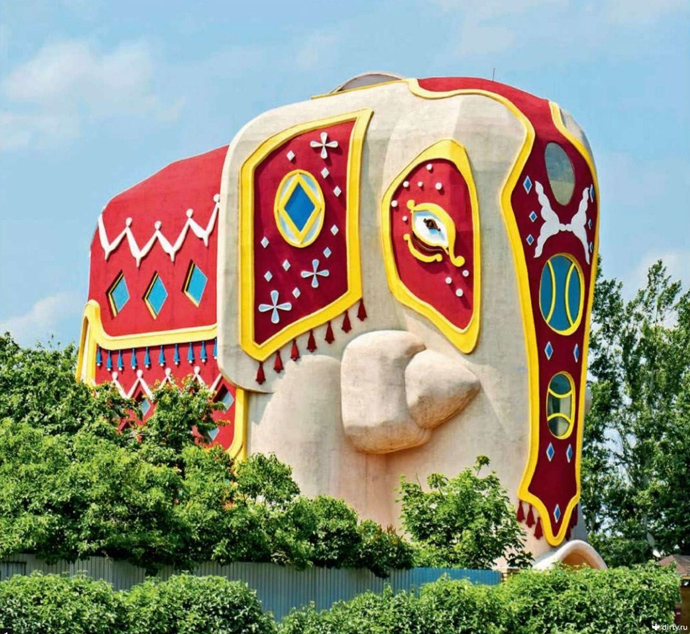
Magic castle in Slovenia
Out-of-reach places, towers, churches and hanging houses are some of the places we are going to go through in this article. If you like, feel free to keep reading. Of course, some of these buildings and places will surprise you! Predjama Castle is located in Slovenia, a sovereign country of Central Europe and which hides many places and places of charm. Predjama and its castle is one of those places that you must know if you like strange places and especially if you like heights.
The castle is in a breathtaking location, as it is in the middle of a cliff. In particular, it is located at an altitude of 123 meters in a cave, from where you can see the nearest town of Postojna, which is about nine kilometers away. The interior of the castle reminds us of typical medieval castles. Despite its construction in such a secluded place, it perfectly retains its essence of an inhospitable and original place.
st. Novaya Basmannaya, 2/1, building 1
Looking at this constructivist building, reminiscent of a steam locomotive, one cannot even believe that its walls remember Napoleon. In the 17th century, the Sovereign Zhitny or Reserve Yard was located here - warehouses where grain and food supplies were stored. According to some information, for the cellars of this palace, ice was delivered from St. Petersburg itself. In the 1750s-1760s, a complex was built here in the form of a square of four long two-story buildings. The Reserve Palace is perhaps the only state-owned building in the capital that survived the fire of 1812.
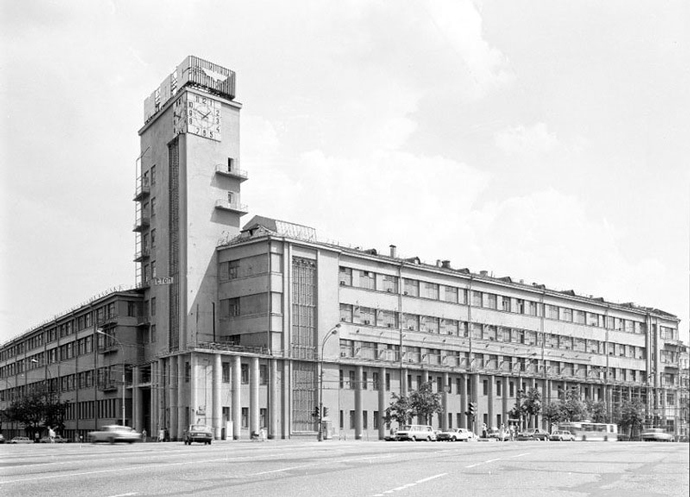
In the 20th century, the Reserve Palace changed owners more than once and underwent restructuring. In the 1900s, the building housed the Institute of Noble Maidens named after Alexander III: designed by architects N.V. Nikitin and A.F. Meissner, the third floor was built on. After the revolution, the building was occupied by the People's Commissariat of Railways. In 1932-1933 the appearance of the building changed radically. Architect I.A. Fomin gave constructivist features to the Reserve Palace: two more floors were added, facades were leveled, forms were changed window openings, and at the corner of Novaya Basmannaya and Sadovaya-Chernogryazskaya streets, a nine-story clock tower rose up, because of which the house was nicknamed the “House with a Chimney” by the people.
st. Mashkova, 1
Mashkova Street, located near the Chistye Prudy metro station, has long been famous for its tenement houses and Art Nouveau buildings, the peak of which was erected at the beginning of the 20th century. But, despite this, today this street is better known for its modern building, namely the egg house.
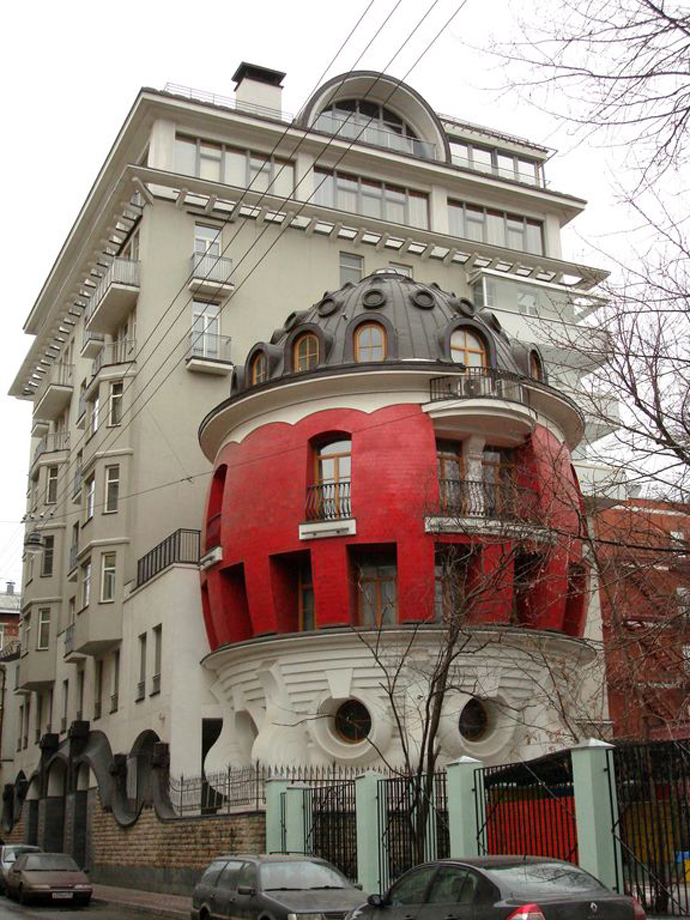
The egg house appeared in 2002 and has become not only a tourist attraction, but also a symbol of all Luzhkov's architecture. The egg house project was created by architect Sergei Tkachenko for a maternity hospital in Bethlehem, but the idea was abandoned there. As a result, the egg house was erected on Mashkov Street as an extension to the new high-rise building. The house has 4 floors and 5 rooms. On the ground floor there is an entrance hall, a hall and a sauna. On the second - a kitchen with a dining room, a servant's room and a bathroom. On the third - living room. On the fourth floor there is a domed room.
st. Nezhinskaya, 13 / st. Dovzhenko, 6
Dom-Bublik is the first round house in Moscow. It was built in 1972 in the Ochakovo-Matveevskoye district in the west of Moscow on the eve of the 1980 Olympics. The unusual shape of the house was designed by architect Yevgeny Stamo and engineer Alexander Markelov. For the construction, standard panels were used, which, in order to close the ring, were placed at an angle of 6 degrees of permissible error. That is why the buildings turned out to be quite impressive. Finding the right one from 26 entrances is not so easy.
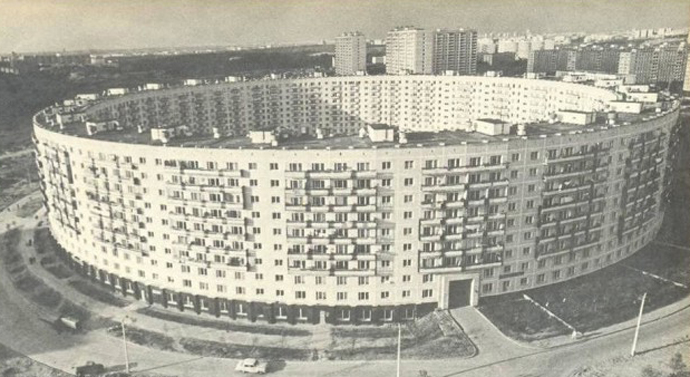
According to the architects' idea, an Olympic village in the form of five ring houses was to appear in Moscow. However, this project proved costly and only two houses were eventually built. Moreover, the twin brother of the first "donut house" appeared only seven years later, in 1979, a year before the Olympics-80 in the west of the capital - in the Ramenki area. At one time, outstanding theater and film actors lived in the house on Nezhinskaya - Honored Artist of the RSFSR Savely Kramarov and Honored Artist of Russia Galina Belyaeva, as well as film director, screenwriter and poet Emil Lotyanu.
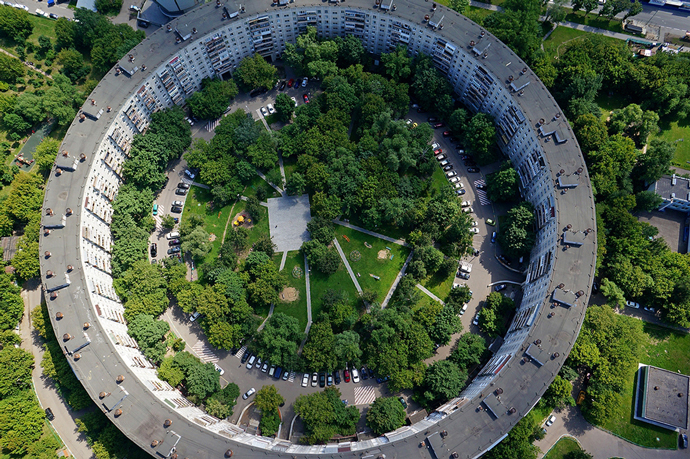
Material prepared: Olga Fursova, Vera Monakhova, Daria Ishkarayeva
The world is beautiful and amazing. It would seem, well, what can you think of standard set"walls, floor and roof". Much more than even the most original imagination can imagine. Here are collected the most, well, very strange buildings and those that even the hand does not rise to categorize as a building.
1. The first place, not strangely, but simply in order, is occupied by the Crooked House, built in Sopot, Poland.
Jan Marcin Szancer, a well-known Polish children's book illustrator, and Per Dahlberg, a Swedish artist living in Sopot, live in the house. The construction of this building began in January 2003, and in December 2003 it already delighted (and / or surprised?) The eyes of the inhabitants of the Polish town and tourists.
2. The house with the intriguing name "Forest Spiral" (Waldspirale (Forest Spiral)) was built in Darmstadt, Germany between 1998 and 2000.
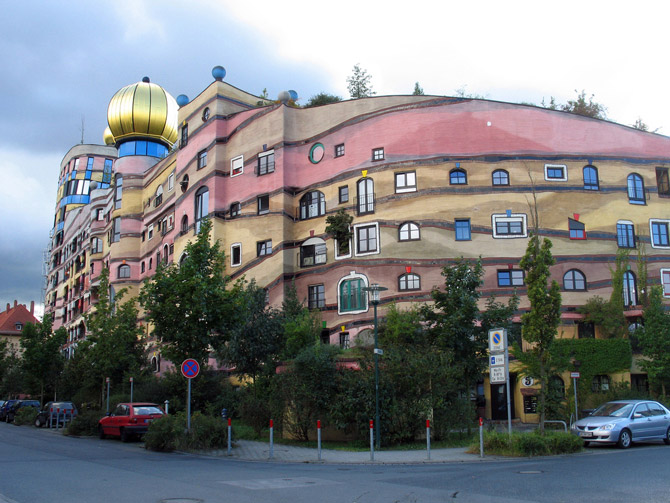
The creation belongs to the hand of a renowned Austrian architect and artist, well known for his revolutionary, colorful architecture. The architect's projects very often borrow their forms from nature - for example, an onion-shaped dome.
This building with 105 apartments, as if "wrapping" around the courtyard, among other things, has a comfortable restaurant with a cozy cocktail bar.
3. Torre Galatea Figueras (The Torre Galatea Figueras). Spain.
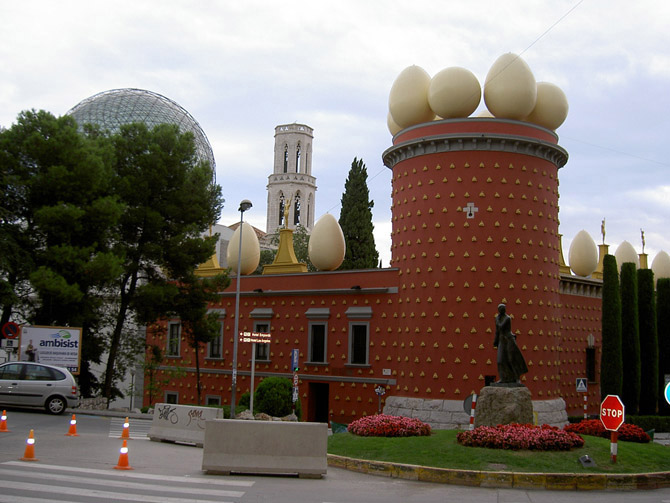
Egg kingdom, yes.
4. Palace of Ferdinand Cheval or the Ideal Palace. (Ferdinand Cheval Palace, Ideal Palace). France.
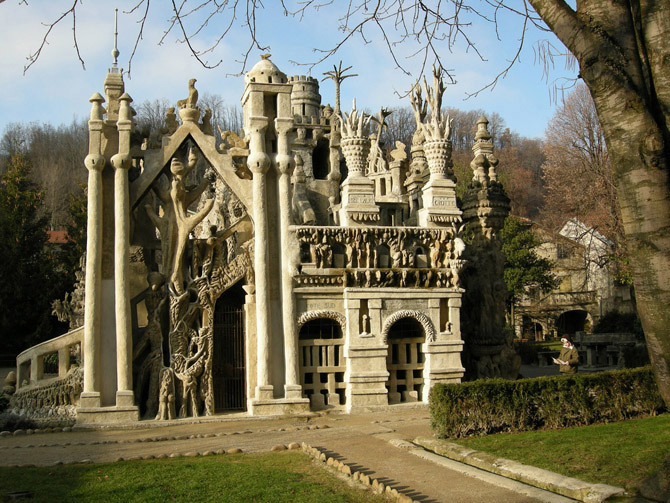
5. Basket building. State of Ohio, USA.
Office construction company Longaberger, based in Newark, Ohio, has to be the strangest office in the world. (Although, we know other, quite interesting examples).
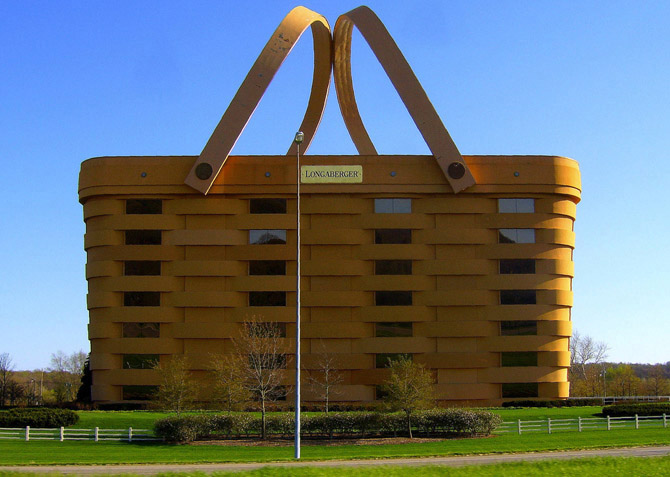
Construction of a building with an area of more than 18,000 square meters, a $30 million replica of the famous picnic basket took two years to complete. Many experts tried to convince Dave Longaberger - the head of the company - to cancel his plans regarding the construction of this building and choose a more familiar form, but he did not want to do this, thanks to which we can see this creation with our own eyes.
6. Public Library in Kansas City, Missouri, USA.
This project, located in the heart of Kansas City, is one of the first projects to restore the city itself and its historical and tourist value.
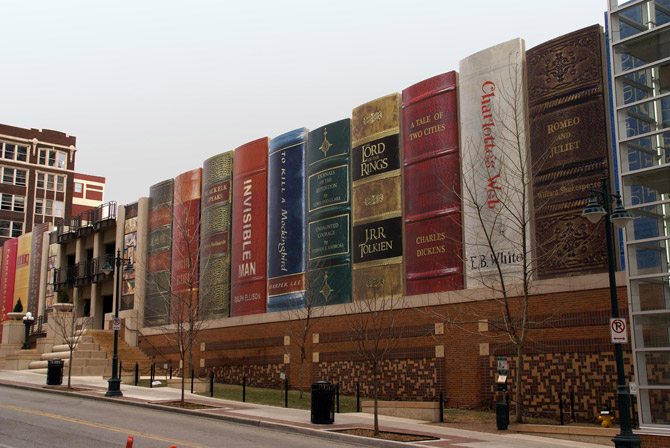
Residents of the city were asked to help pick up the most famous books that are somehow connected with the name of Kansas City. These publications have been incorporated into the innovative design of the Central City Library to encourage visits.
7. Upside down house. State of Tennessee, America.
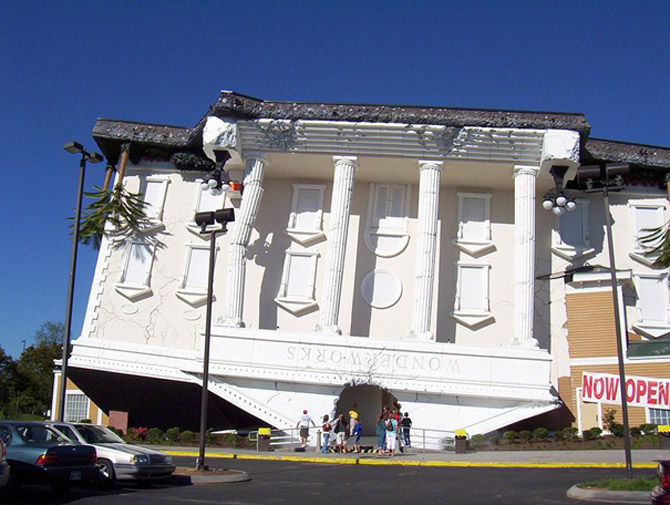
8. Habitat 67 (Habitat 67). Canada.
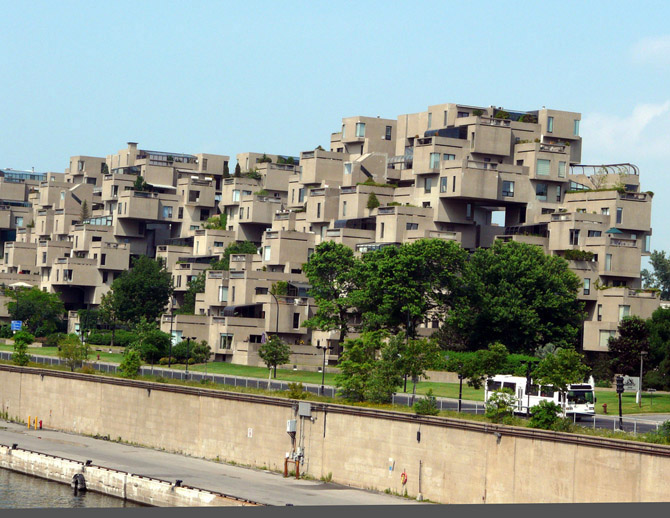
In 1967, Canada hosted one of the largest world exhibitions of that time - Expo 67. The main theme of the exhibition was houses and residential construction.
The cube is the basis of this structure, called Habitat 67, completed in time for the exhibition. In a material sense, the cube is a symbol of stability. As for its mystical meaning, the cube is a symbol of wisdom, truth and moral perfection.
354 cubes stacked on top of each other made it possible to create this gray (in color, not in essence) building with 146 apartments floating between heaven and earth, between city and rivers, between greenery and light.
9. Cubic houses. Rotterdam, the Netherlands.
The original idea for these cubic houses originated in the 1970s. Piet Blom designed a couple of these houses, which were then built in Helmond.
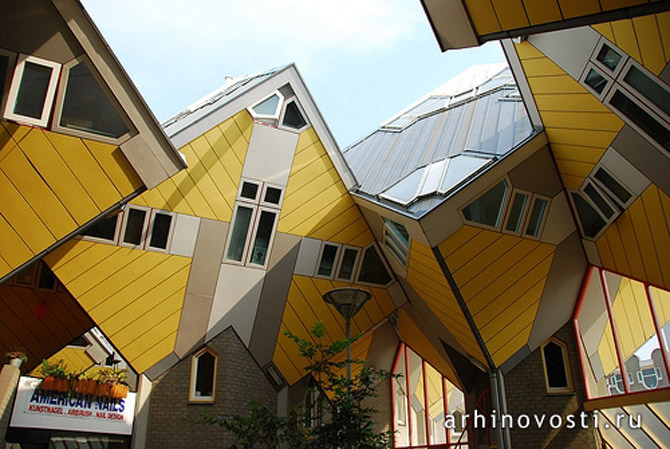
When the architect received an order for the design of houses in Rotterdam, he decided to use the cubic idea for this project as well. Another nuance of construction is that each house resembles an abstract tree, which is why the whole village turns into a forest.
10. Hotel or crazy house (Guesthouse aka Crazy House). Hang Nga, Vietnam.
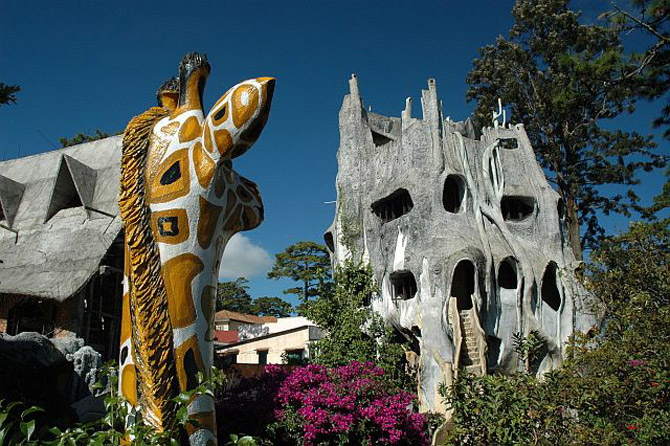
The house belongs to the daughter of the ex-president Socialist Republic Vietnam. At one time, this Vietnamese lady studied architecture in Moscow.
The structure does not comply with any of the generally accepted concepts of housing construction and looks like a fairy-tale castle, with a huge belly of a giraffe or a spider. The house is open to tourists.
11. Chapel. (Chapel in the Rock). State of Arizona, USA.
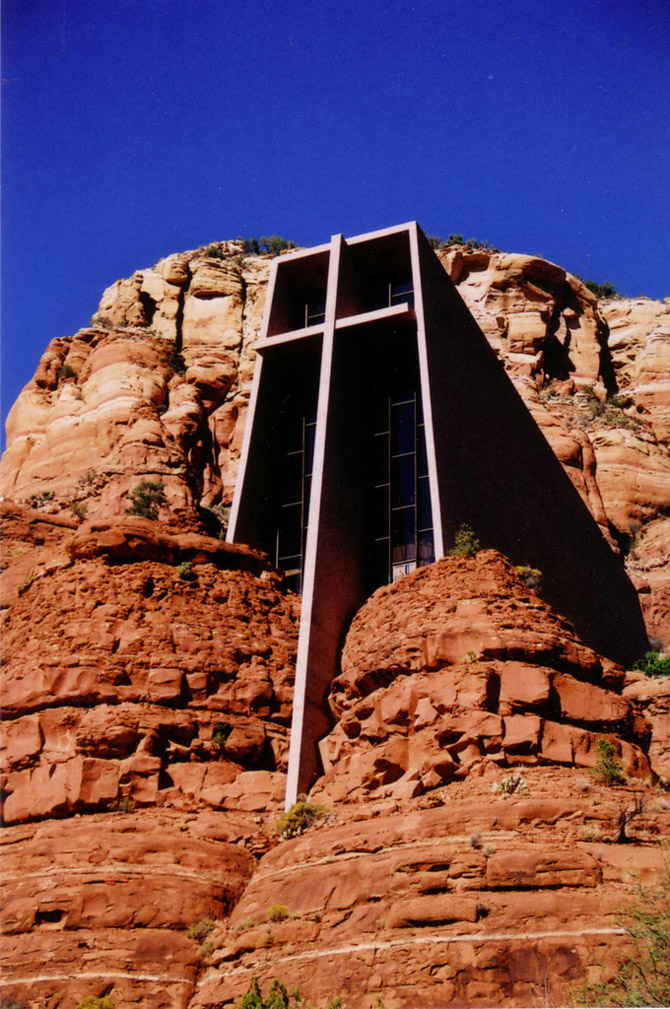
12. Dancing Buildings Prague, Czech Republic.
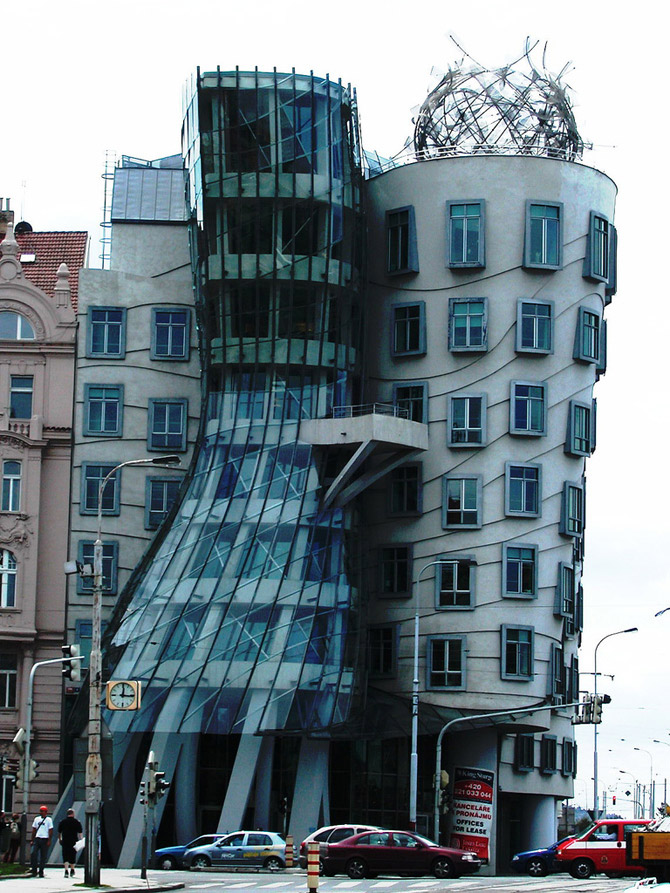
13. Building-washing machine (Calakmul building, La Lavadora, The Washing Machine). Mexico City, Mexico.
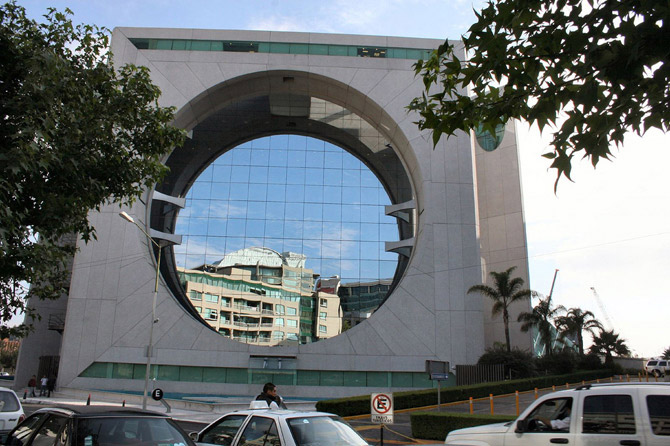
14. House-kettle (Kettle House). Texas, USA.
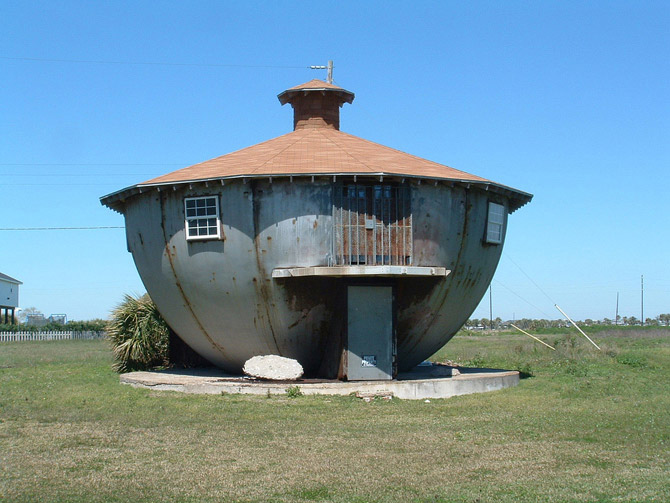
15. Manchester Civil Justice Centre. Manchester, UK.
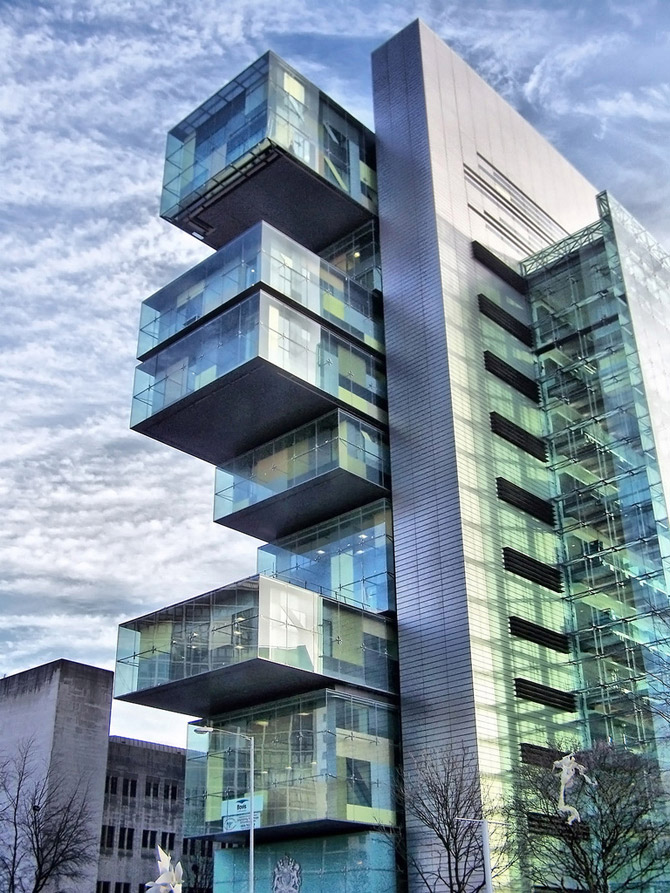
16. Nakaginskaya tower - capsule. (Nakagin Capsule Tower). Tokyo, Japan.
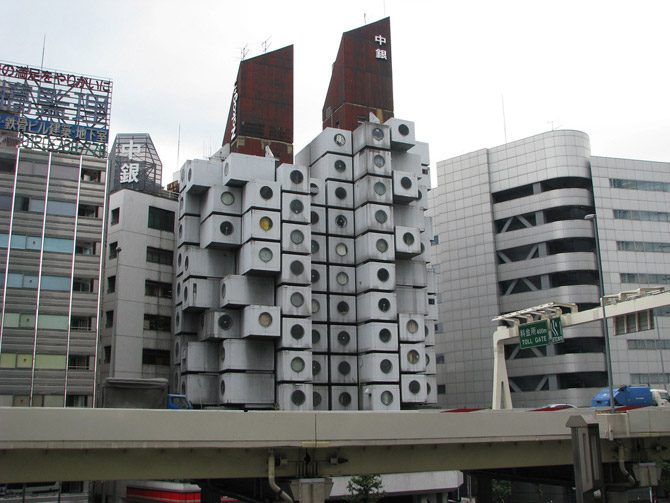
17. Surreal house (Mind House). Barcelona, Spain.
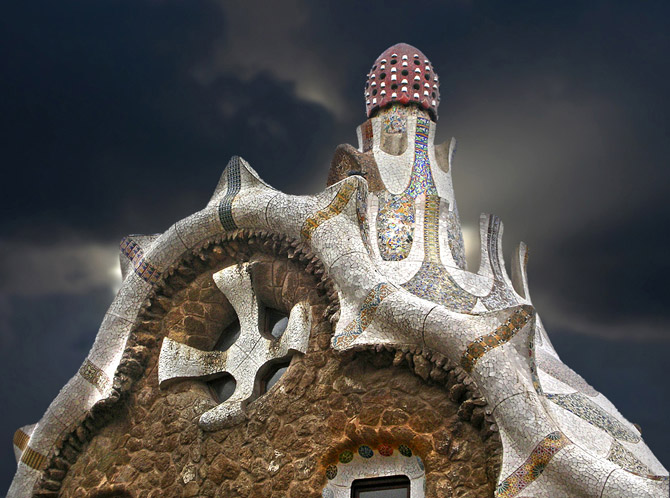
Surrealism is what makes even the most indifferent hearts come alive and clearly (but unevenly) tremble. Salvador Dali, who once lived in Catalonia (a region of Spain) and worked, inspired by his woman, for the benefit of the surrealist direction, still stimulates the creative impulses of architects to create unusual houses around the world and in particular in Spain.
18. Stone House. Guemaraes, Portugal.
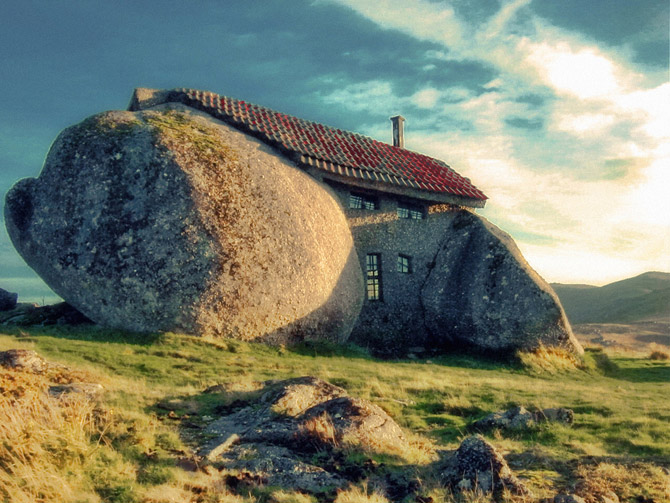
19. Shoe House. Pennsylvania, America.
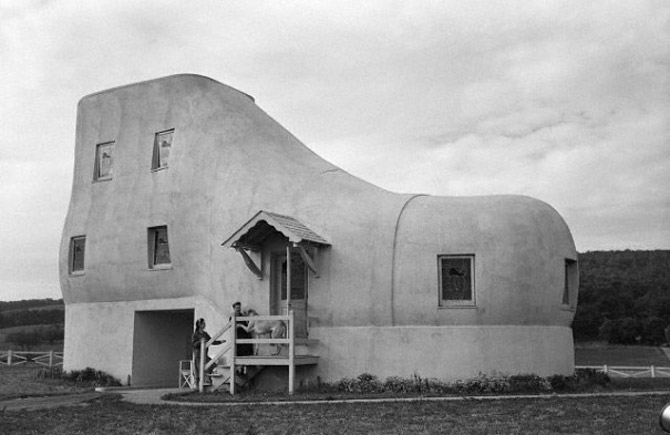
20. Weird House Alps.
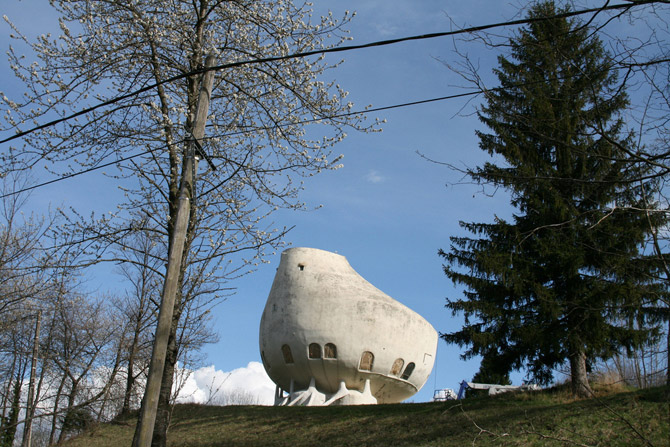
21. UFO House (The Ufo House). Sanji, Taiwan.
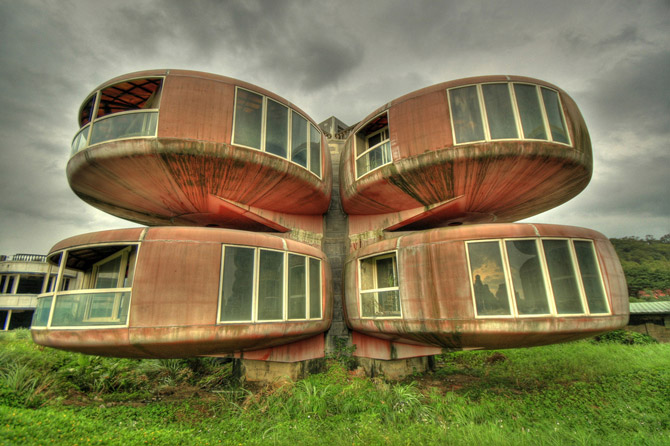
22. Hole-house (The Hole House). State of Texas, USA.
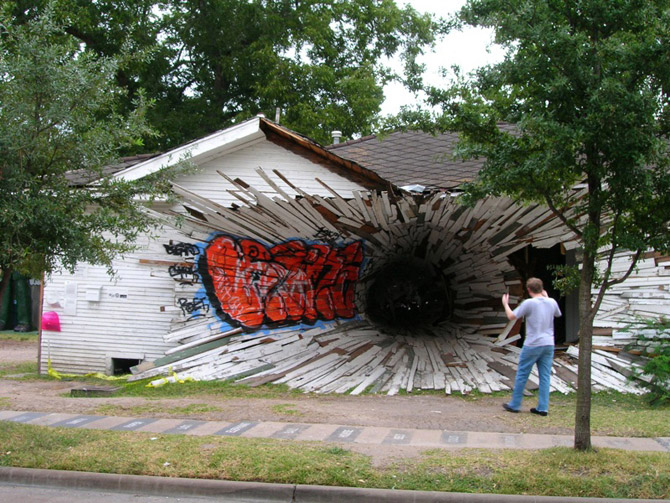
23. Ryugyong Hotel. Pyongyang, North Korea.
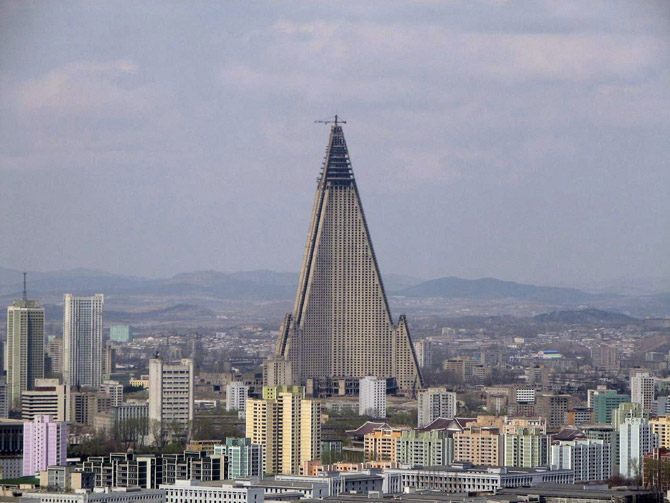
24. National Library. Minsk, Belarus.
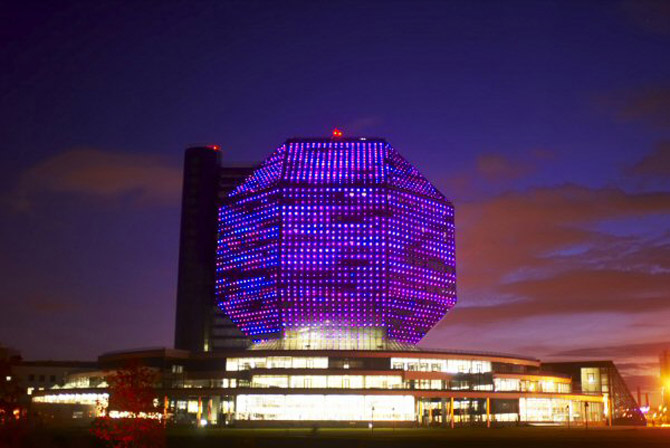
25. Large pineapple (Grand Lisboa). Macau.
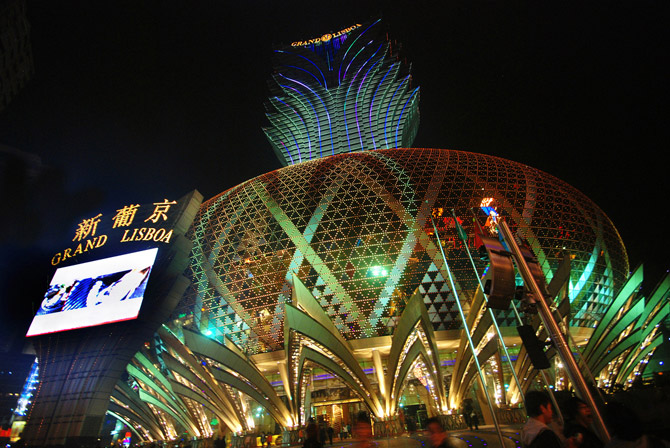
26. House-wall (Wall House). Groningen, Holland.
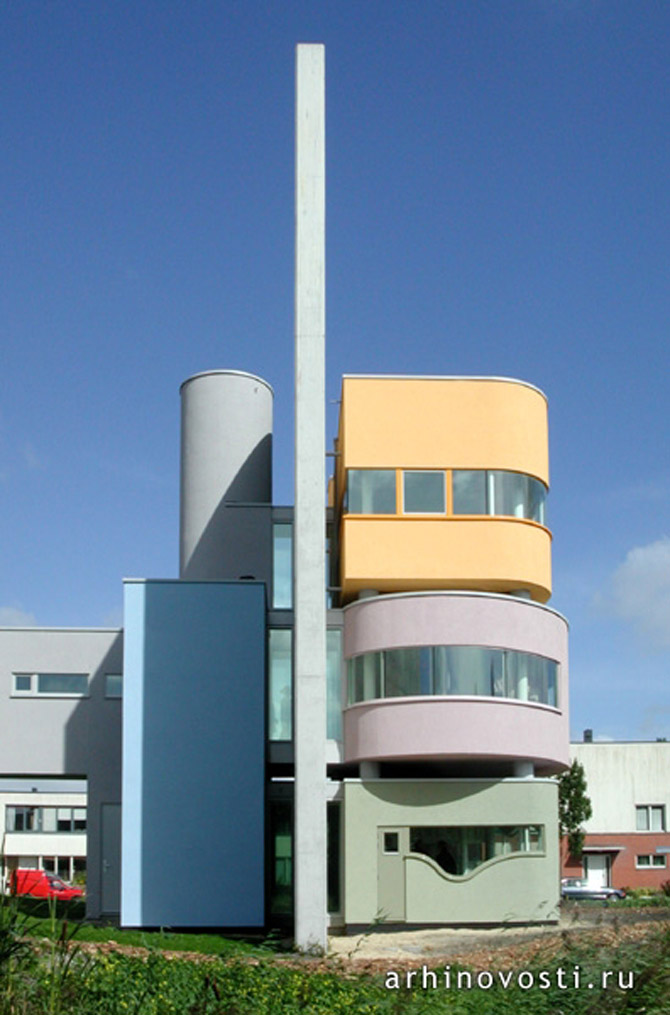
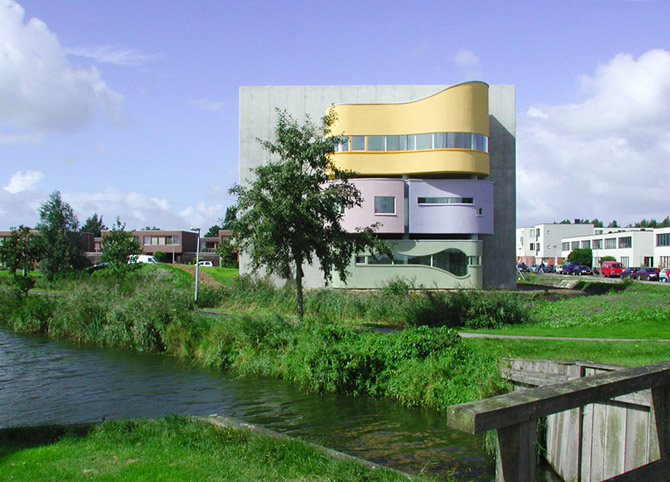
27. Guggenheim Museum. Bilbao, Spain.
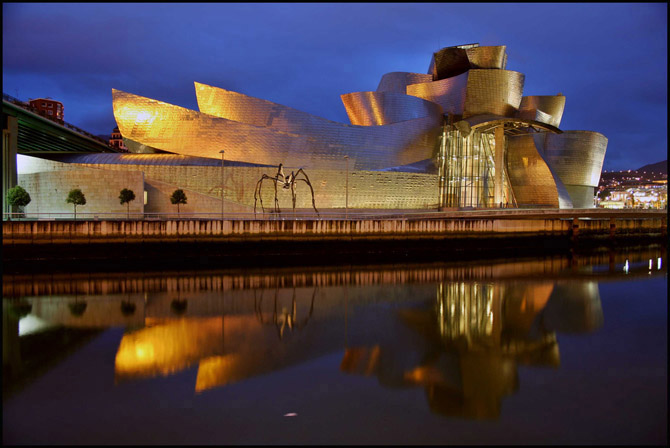
28. House of Worship or Lotus Temple (Bahá'í House of Worship, Lotus Templ). Delhi, India.
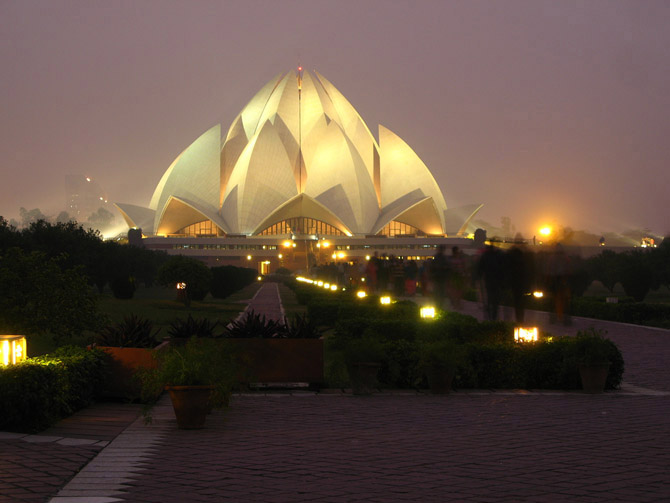
29. House-container (Container City). London, Great Britain.
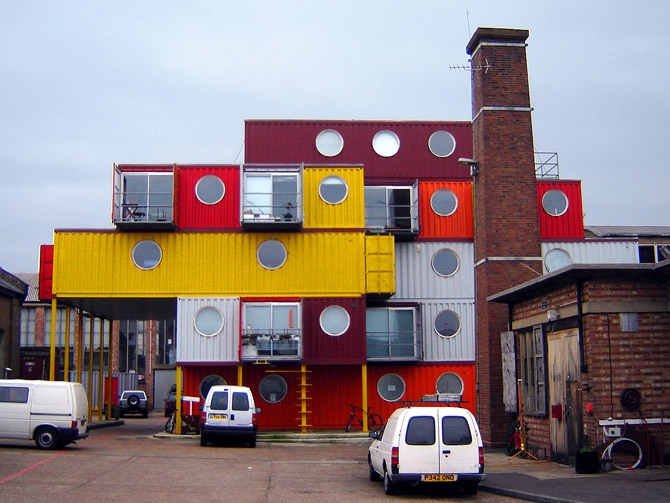
30. Attacked house (House Attack). Vienna, Austria.
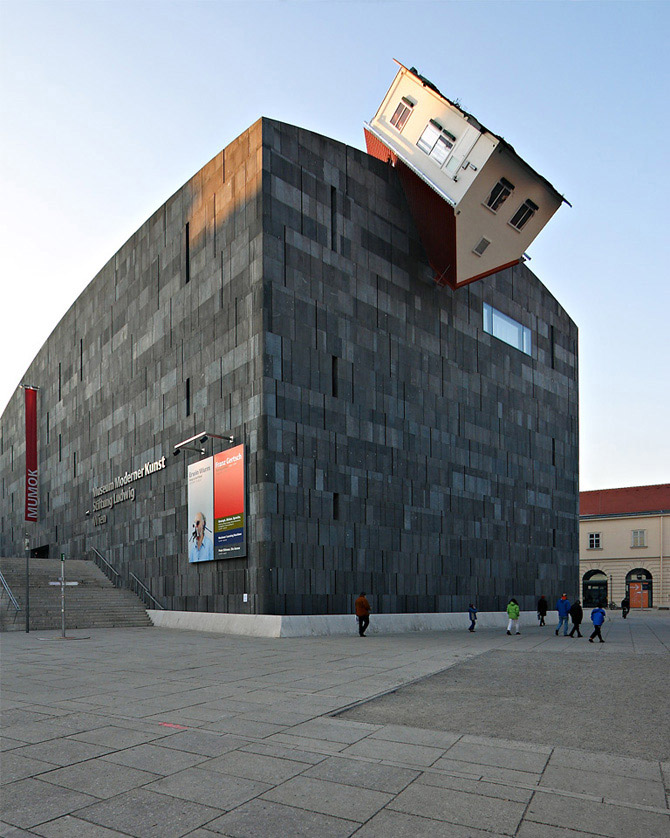
The idea for this house belongs to famous architect Erwin Wurm.
31. Wooden house for the gangster. Arkhangelsk, Russia.
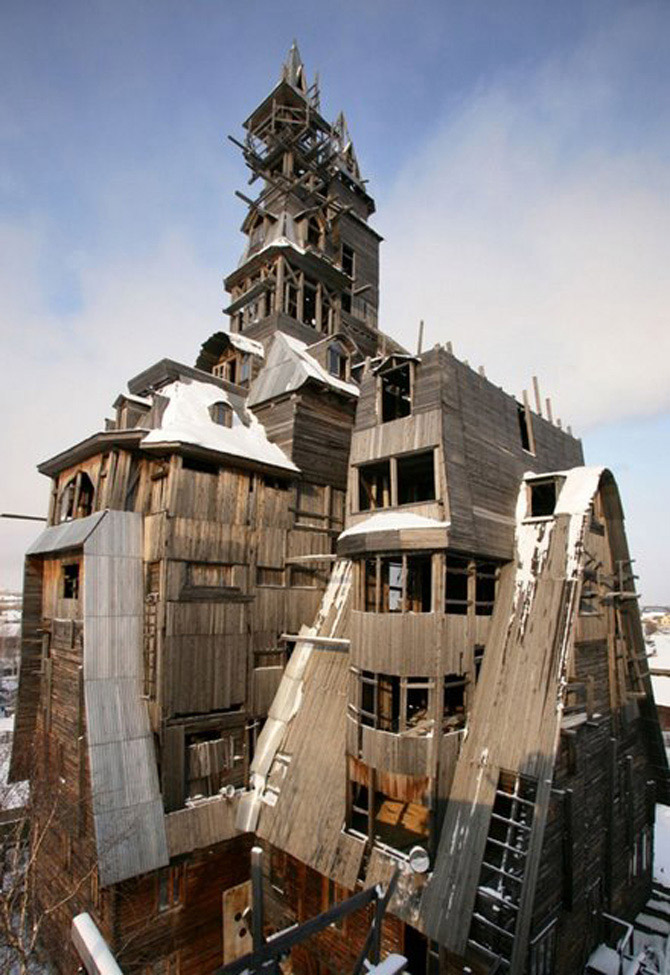
Live a century, travel a century! Who would have known that in Russia there is such an unusual and grandiose house! It is not clear only the presence of voids in the walls of this structure. We can only guess whether it was the author's idea or the tree ran out in Arkhangelsk.
32. Air Force Academy Chapel. Colorado, USA.
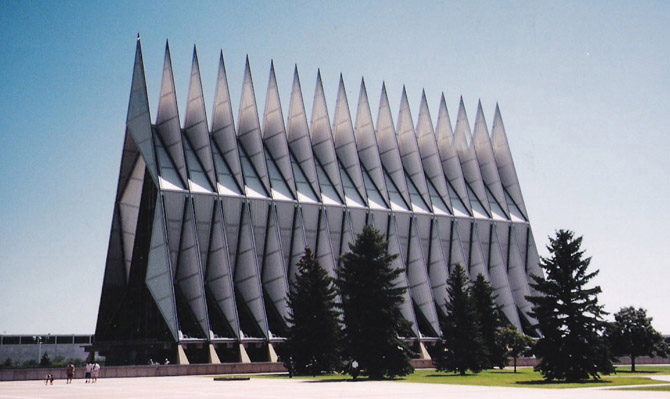
33. House-solar battery (Solar Furnace). Odeillo, France.
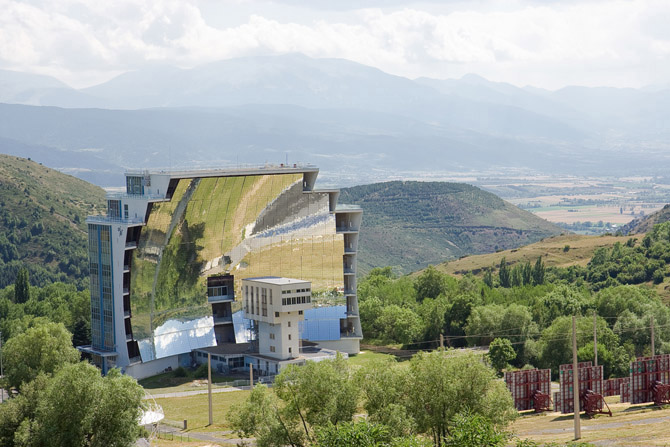
The battery house, as you understand, fully provides itself with electricity and everything necessary to sustain life. Now it remains only to wait for him to launch a rocket into space.
34. House-dome (Dome House). Florida, USA.
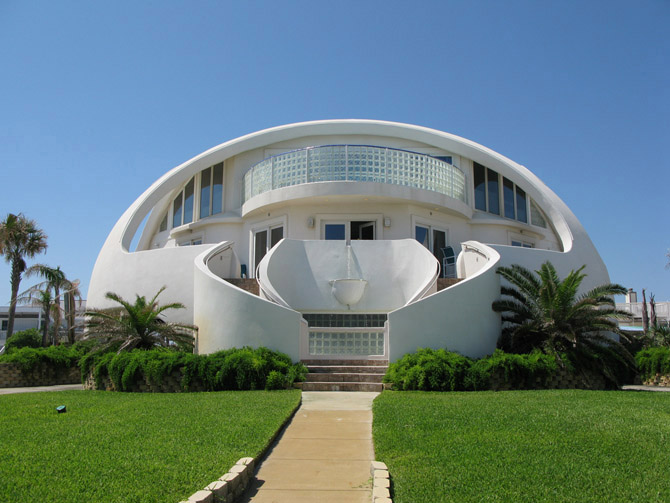
35. Beijing National Stadium. Beijing, China.
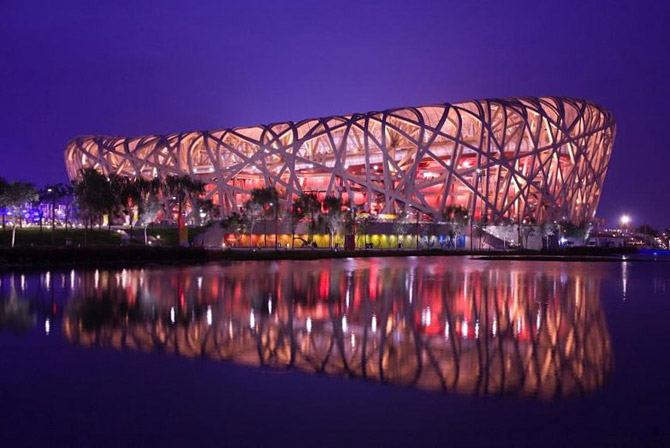
36. House of fashion and shopping (Fashion Show Mall). Las Vegas, USA.
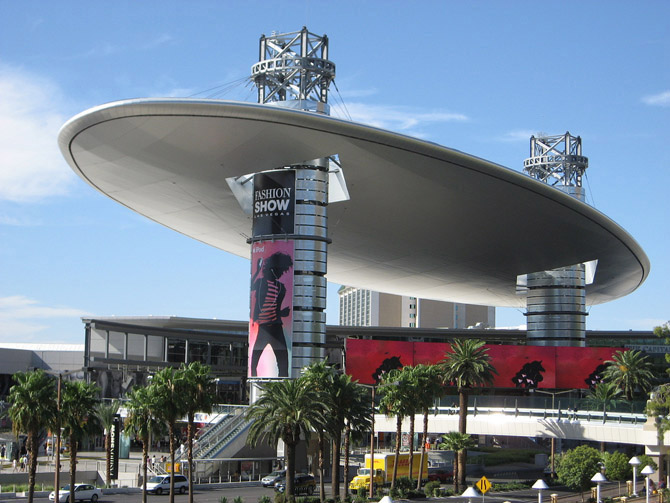
37. Luxor Hotel and Casino (Luxor Hotel & Casino). Las Vegas, USA.
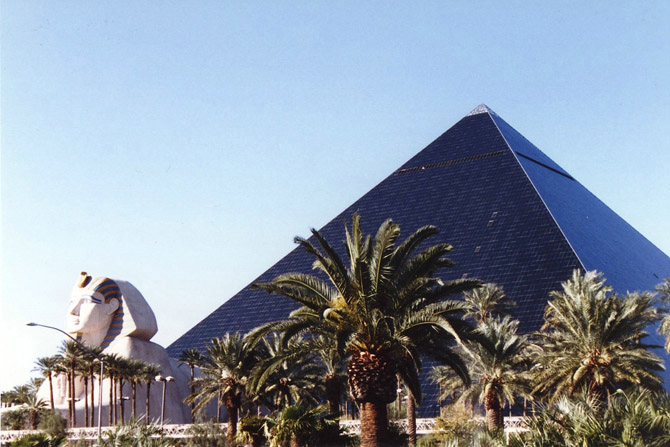
And we thought that this thing was dug up in Egypt.
38. Stadium "Zenith Europe" (Zenith Europe). Strasbourg, France.
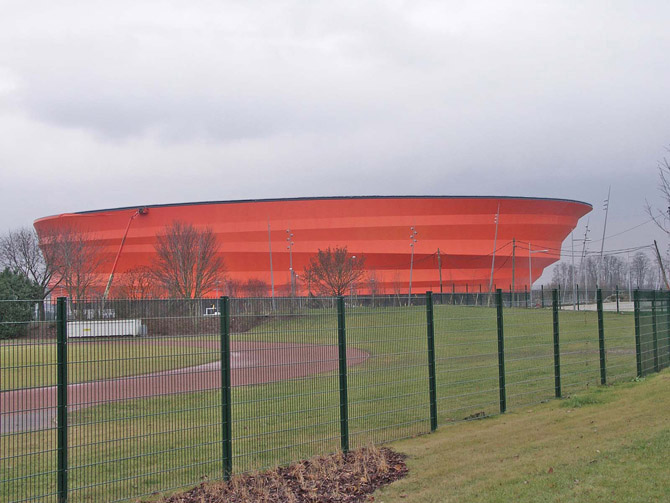
39. Civil Center (Civic Center). Santa Monica.
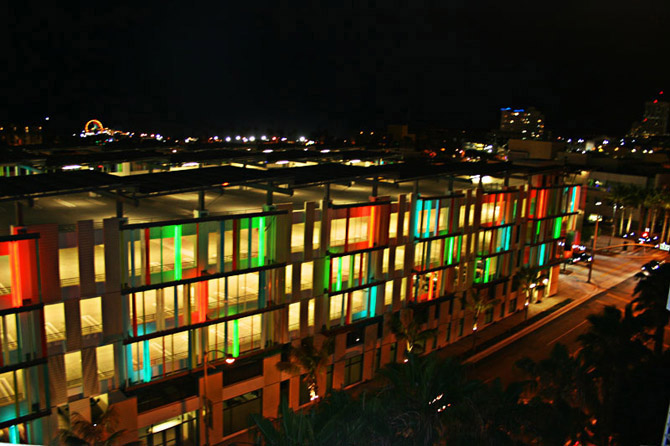
40. Mammy's Cupboard House. Naches, America.
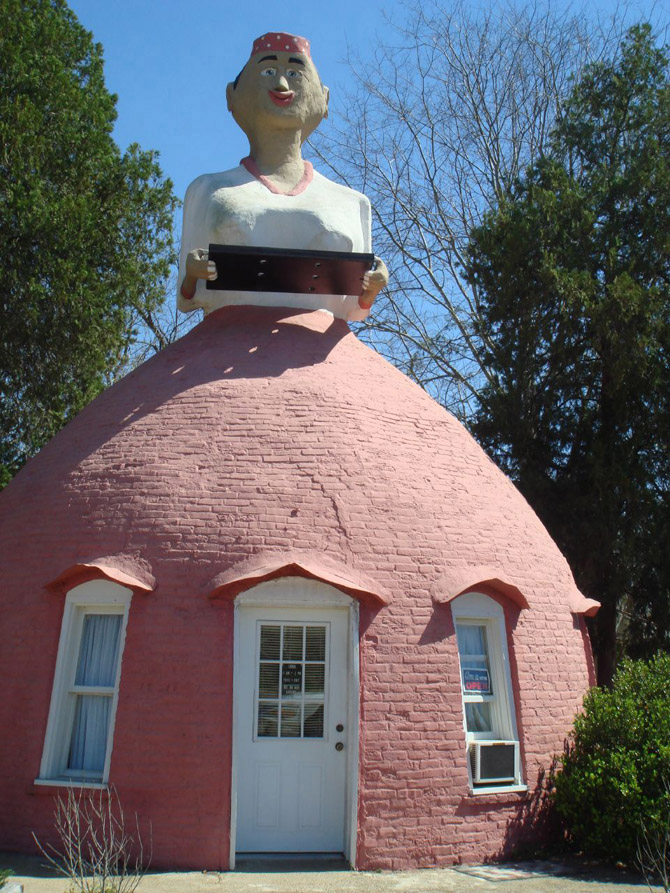
41. Pickle Barrel House Grand Marais, Michigan, USA.
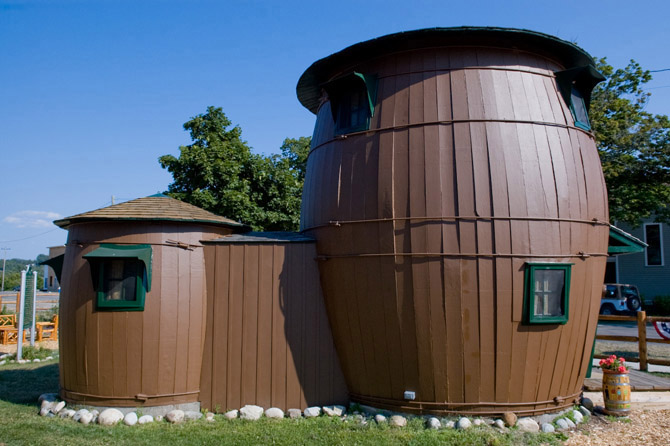
42. Egg (The Egg). Empire State Plaza, Albany, New York, USA.
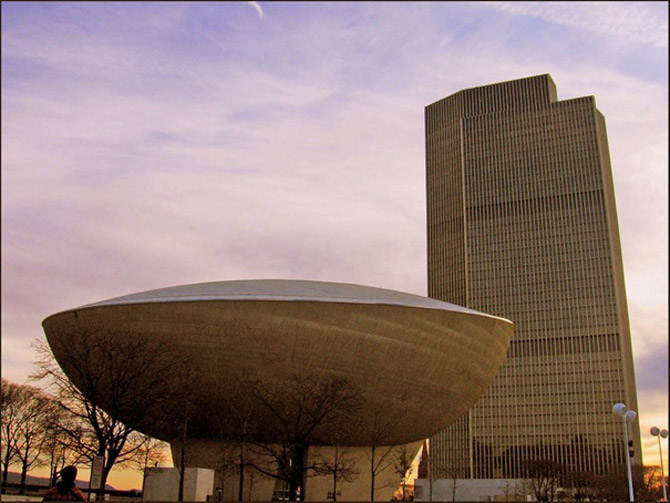
43. Building-cucumber (Gherkin Building). London, Great Britain.
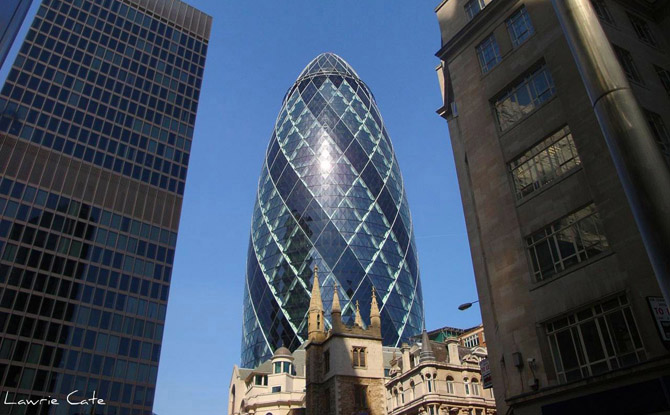
44. Nord LB building. Hanover, Germany.
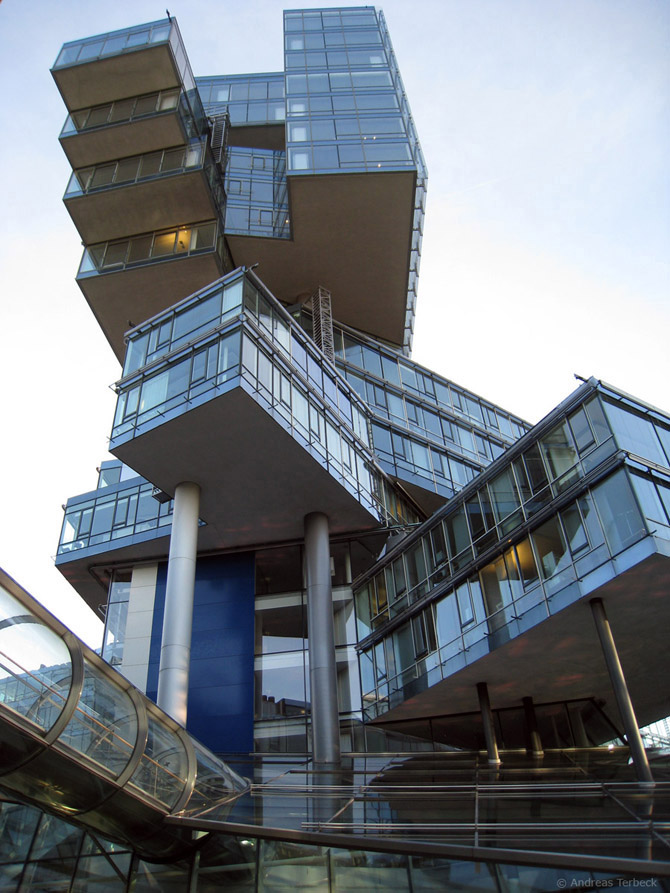
45. Lloyd's building office. London, Great Britain.
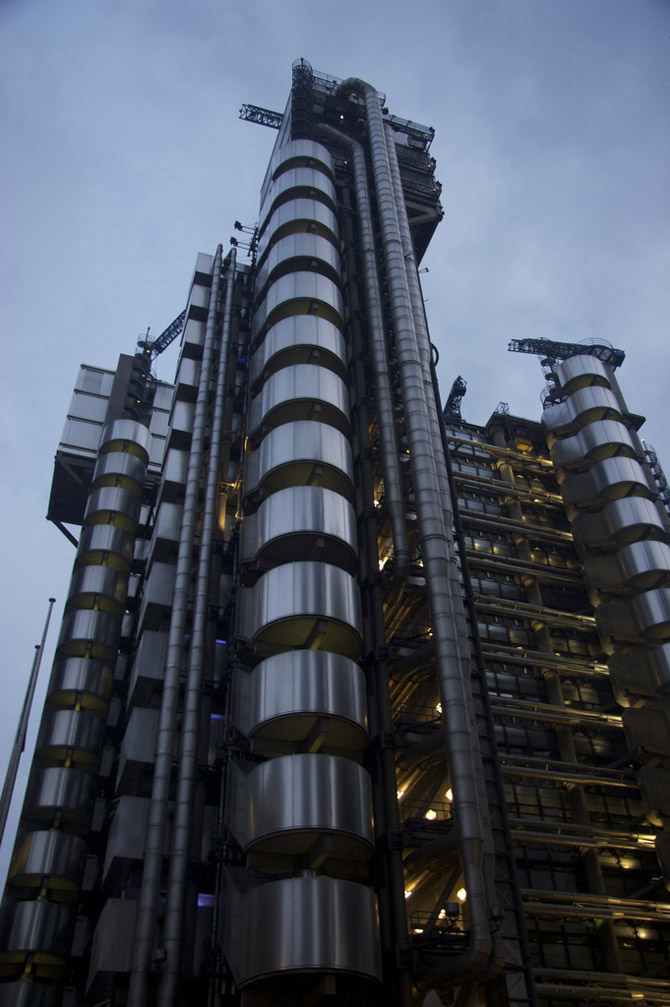
46. "Friendship". Yalta, Ukraine.
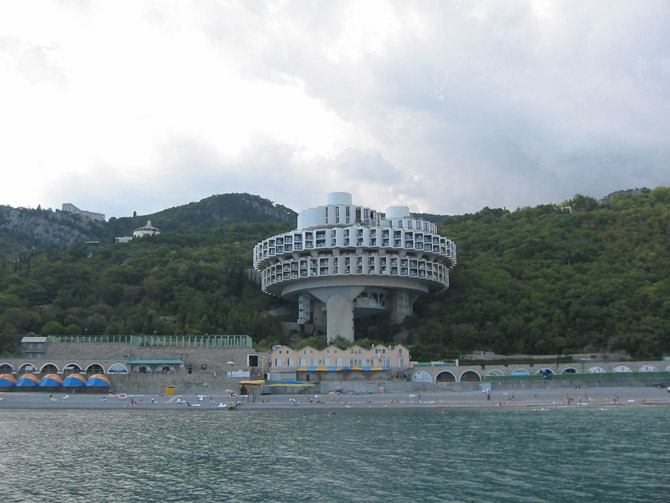
47. The building of the company Fuji-TV (Fuji television). Tokyo, Japan.
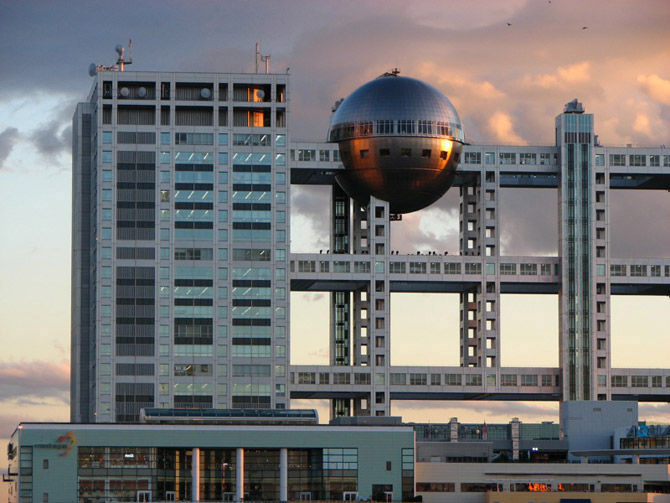
48. UCSD Geisel. Library. San Diego, California, USA.
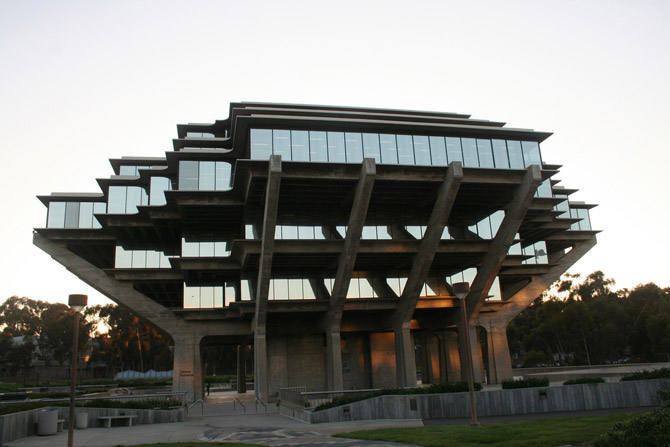
49. House "with a crack." Ontario, Canada.
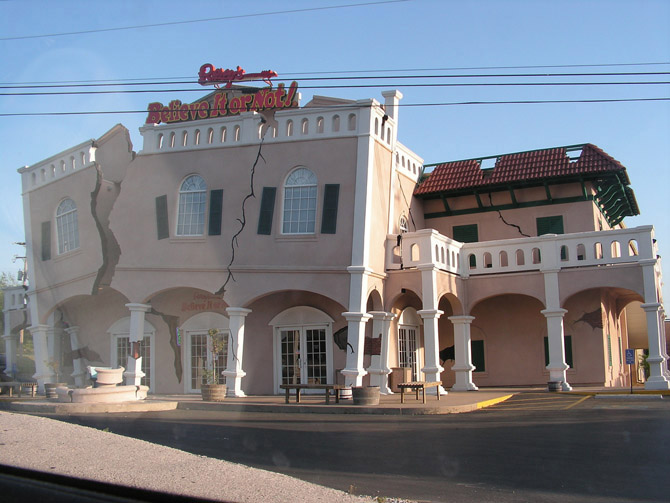
50. Bank of Asia or Robot Building (The Bank of Asia aka Robot Building). Bangkok, Thailand.
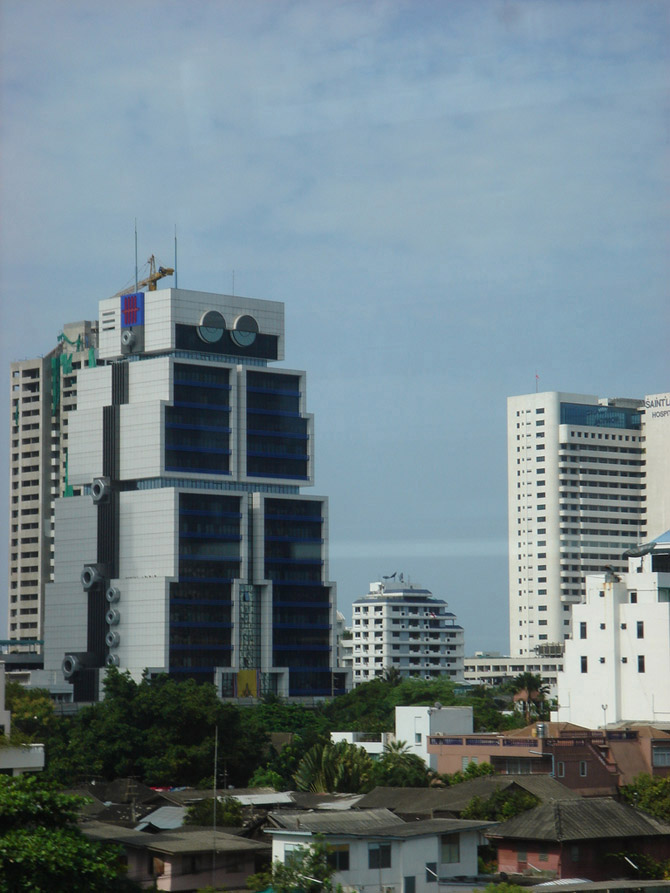
51. office center"1000" or "Banknote". Kaunas, Lithuania.
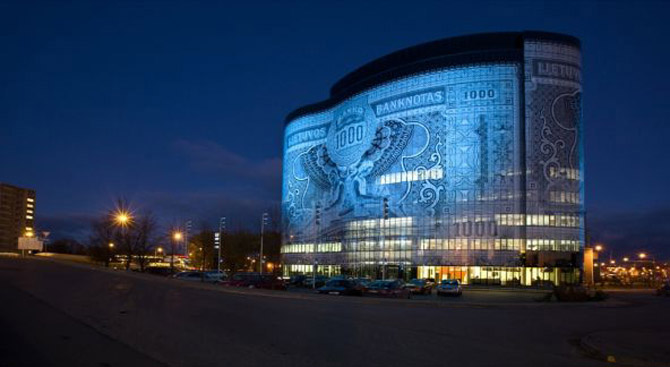
The building, which was built from 2005 to 2008, was conceived by architects Rimas Adomaitis, Raimundas Babrauskas, Darius Siaurodinas and Virgilijus Jocys.
52. House-boat (House Boats). Kerala, India.
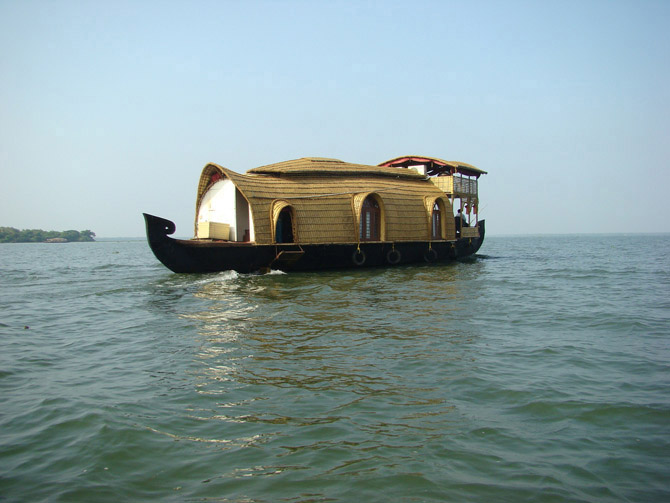
53. Olympic Stadium (Olympic Stadium). Montreal, Quebec, Canada.
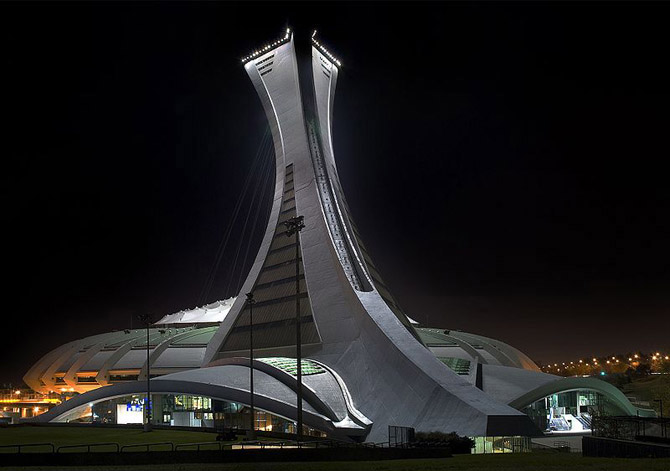
54. Blue building (Blur Building). Yverdon-les-Bains, Switzerland.
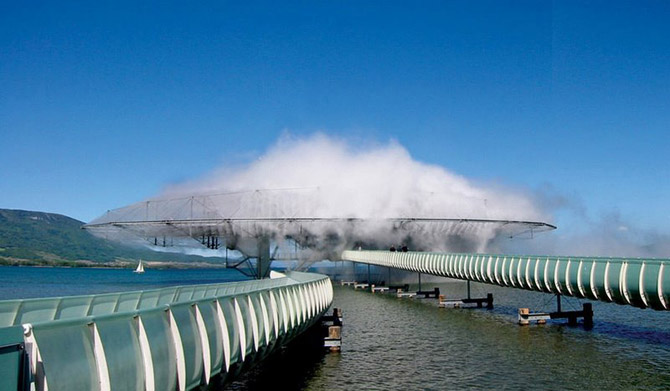
This unusual "ocean" building was built on the occasion of Expo 2002 by the architectural studio Diller Scofidio and Renfro (Diller Scofidio + Renfro).
55. Concert Hall in Tenerife (Tenerife Concert Hall). Santa Cruz de Tenerife, Canary Islands, Spain.
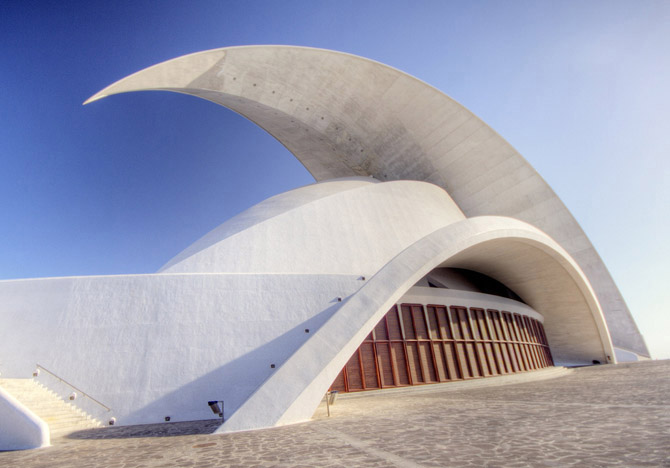
56. House, "in which you have never been" (The Never Was Haul). Berkeley, California, USA.
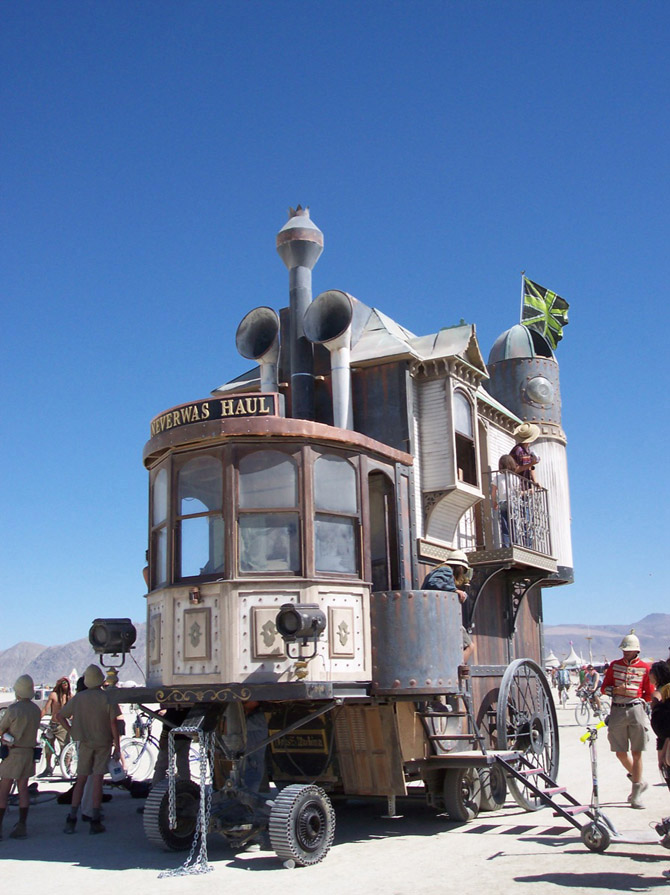
Another example of a surrealistic view of architecture.
57. Gateway to Europe or the office of the company Torres KIO (Torres KIO). Madrid, Spain.
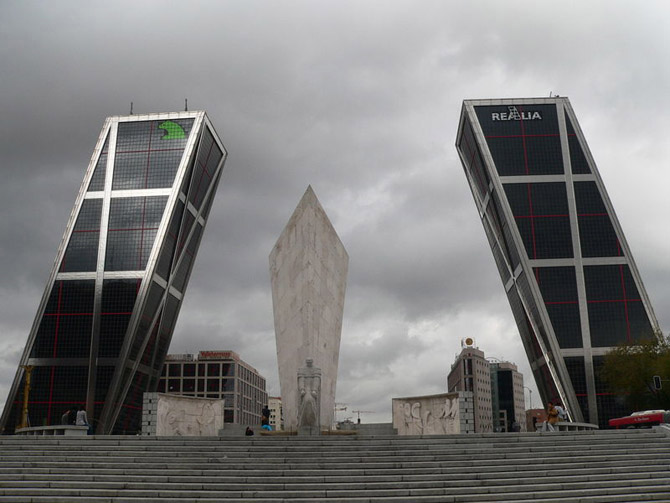
These two towers are the world's first experience in the construction of inclined high-rise buildings.
58. UFO house. New Zealand.
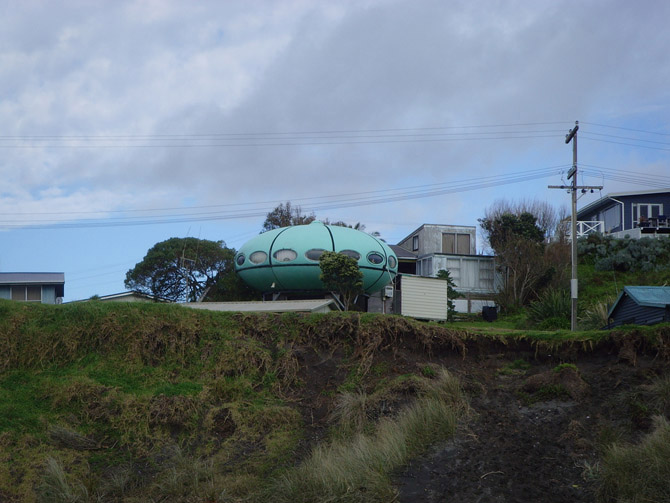
59. Department for the problems of extraction and supply of natural gas (Gas Natural headquarters). Barcelona, Spain.
![]()
60. Walt Disney Concert Hall. Los Angeles, California, USA.
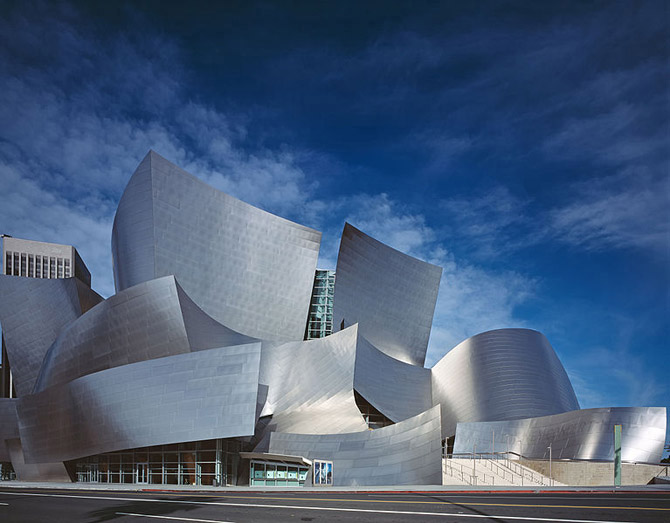
This grandiose hall is the fruit of the efforts of the famous Frank Henry (Frank Gehry). 1987-2003.
61. Cob House Vancouver, Canada.
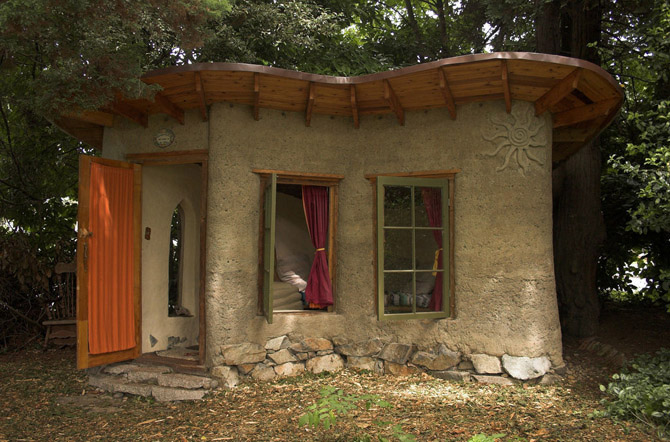
62. Mushroom House or Tree House (The Mushroom House aka Tree House). Cincinnati, Ohio, USA.
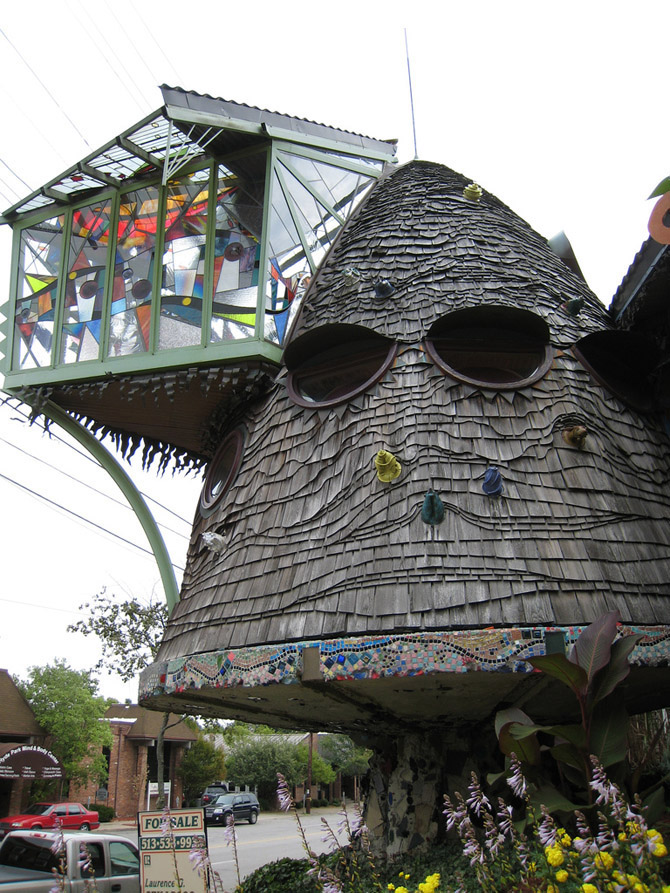
63. House-dungeon. Location unknown.
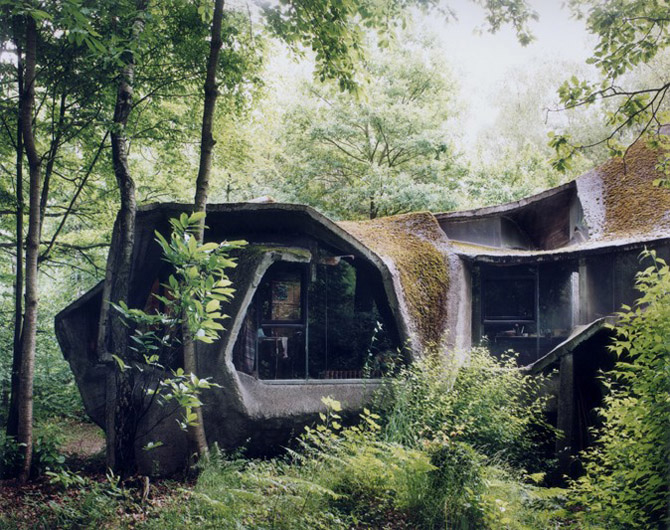
64. House-panorama (Edificio Mirador). Madrid, Spain.
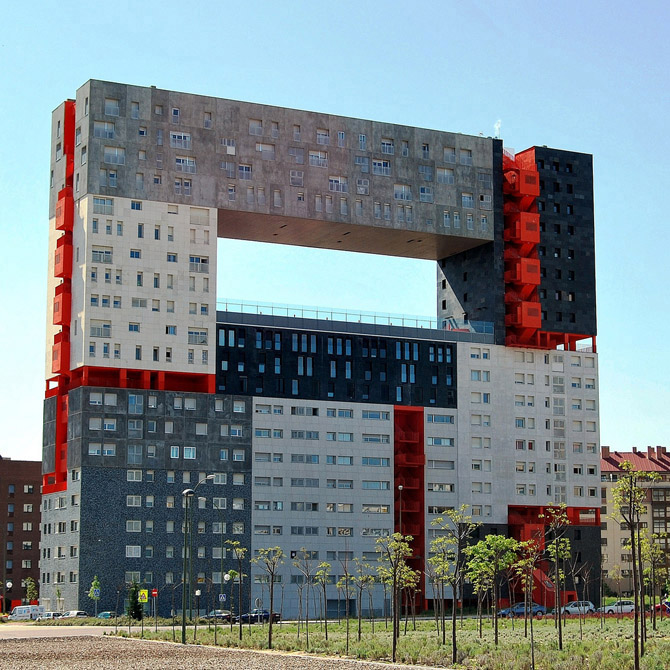
This building was designed by the Dutch architects MVRDV. The building reaches 63.4 meters in height. In the center is a large central hole, which is 36.8 meters above the ground. This is a large viewing area. The remaining blocks serve as a residential area with 9 various types apartments.
65. Home - Free Spirit Spheres. Qualicum Beach, British Columbia, Canada.
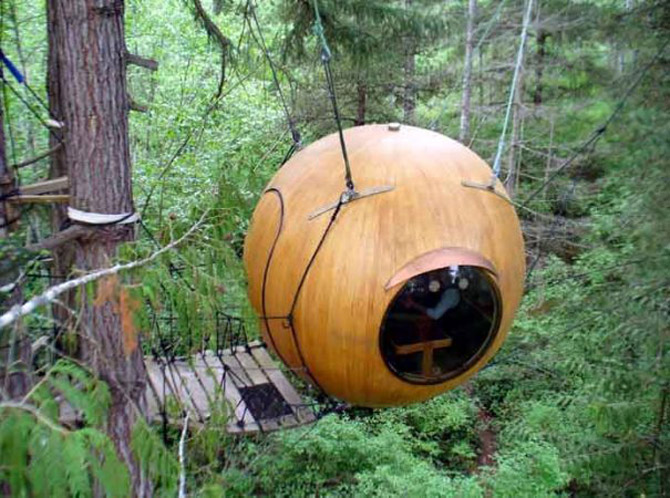
66. Municipal building. Tempe, Arizona, USA.
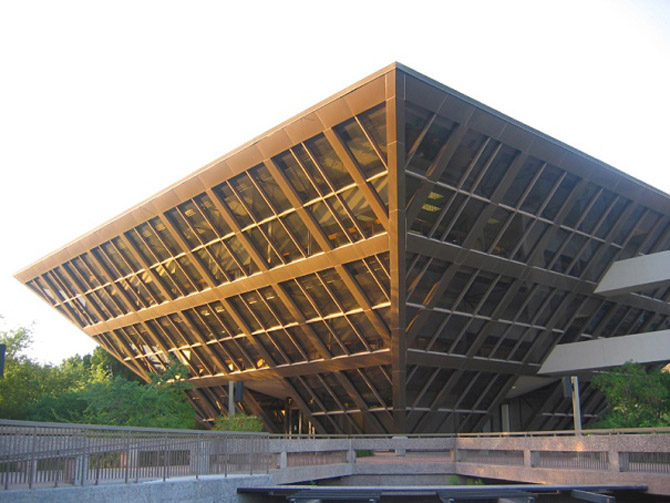
67. Tree house. Papua New Guinea, Indonesia.
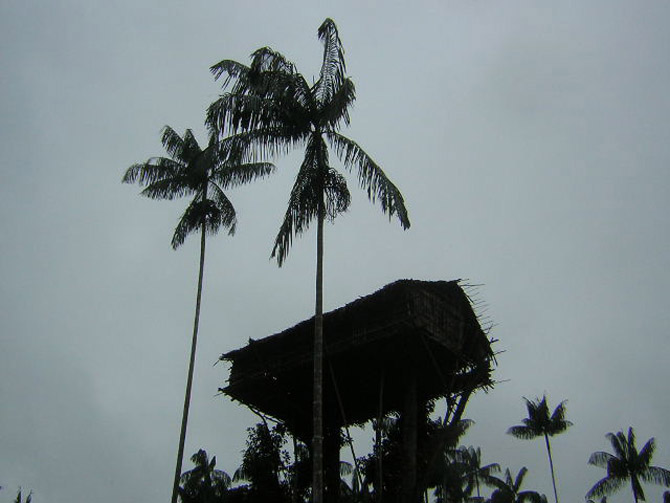
68. Turning Torso. Malmö, Sweden.
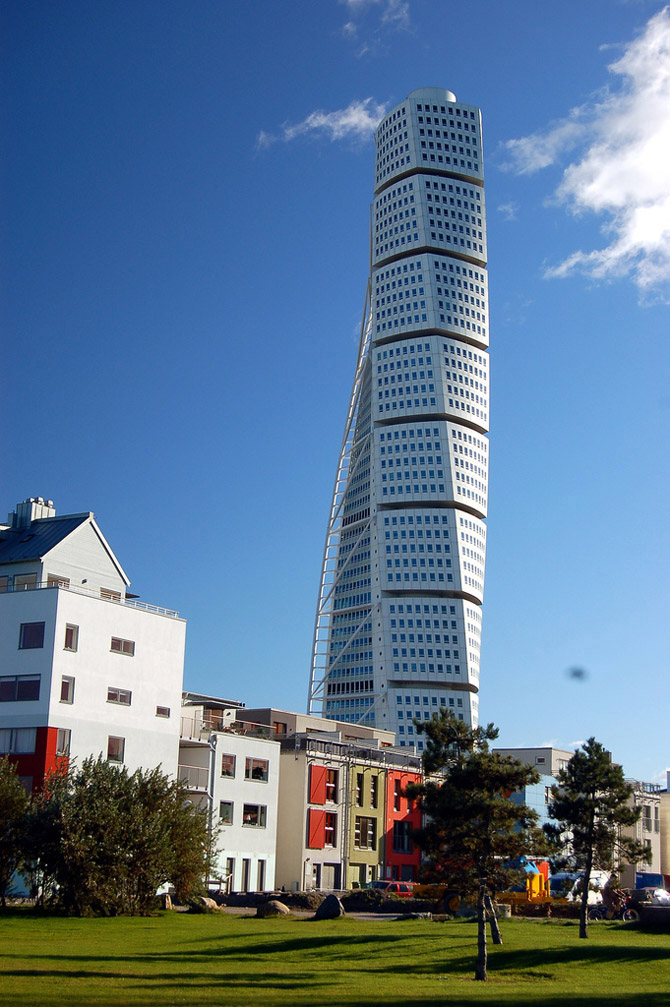
Architect Santiago Calatrava. 2005.
69. Apartments. Amsterdam, Holland.
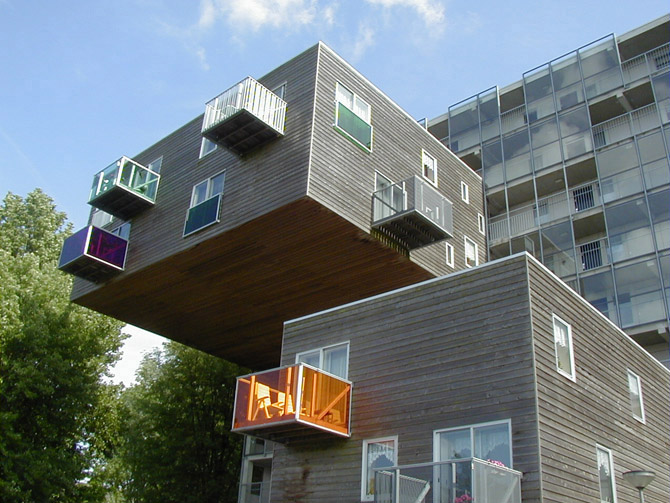
70. Dormitory of Cambridge, Massachusetts, USA.
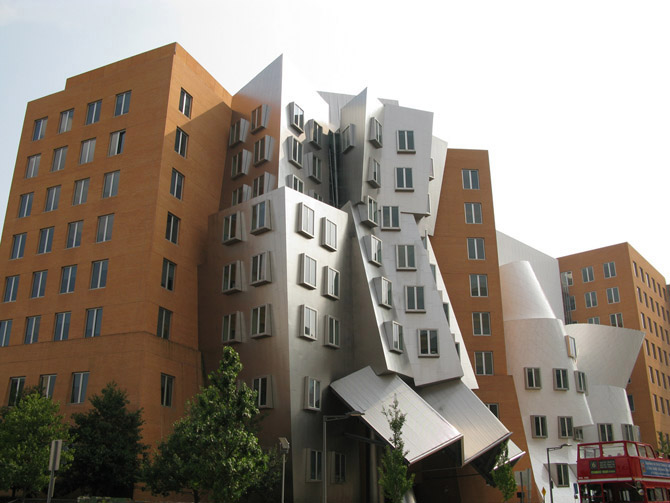
71. Great Mosque (Great Mosque). Jenne, Mali.
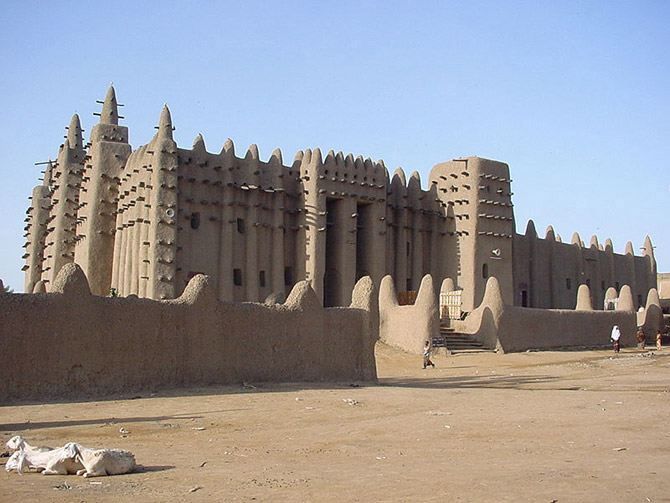
72. Glass House Boswell, British Columbia, Canada.
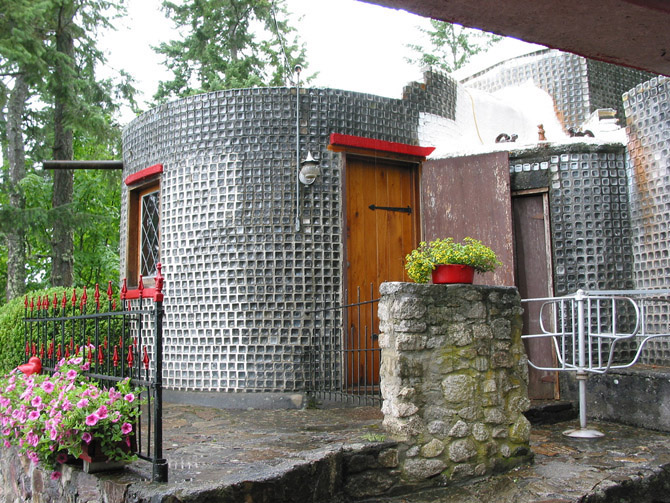
73. House of beer. Houston, Texas, USA.
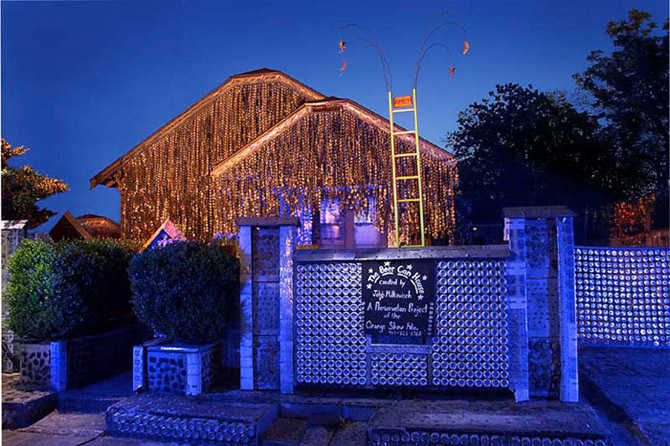
74. Strawberry Ice-cream shop. North Carolina, USA.
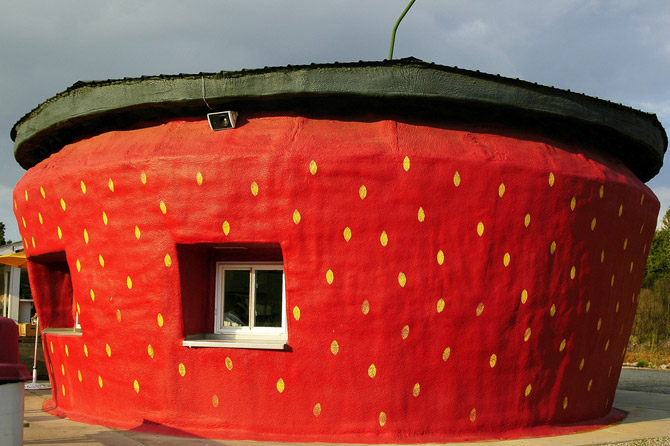
75. In pursuit of the previous building - a strawberry house. Tokyo, Japan.
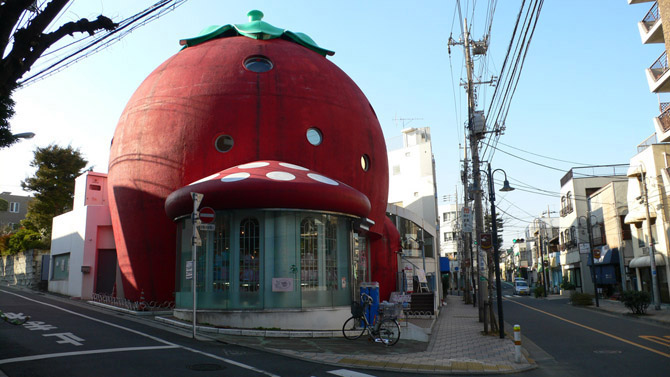
76. House-sculpture (Sculptured House). Colorado, USA.
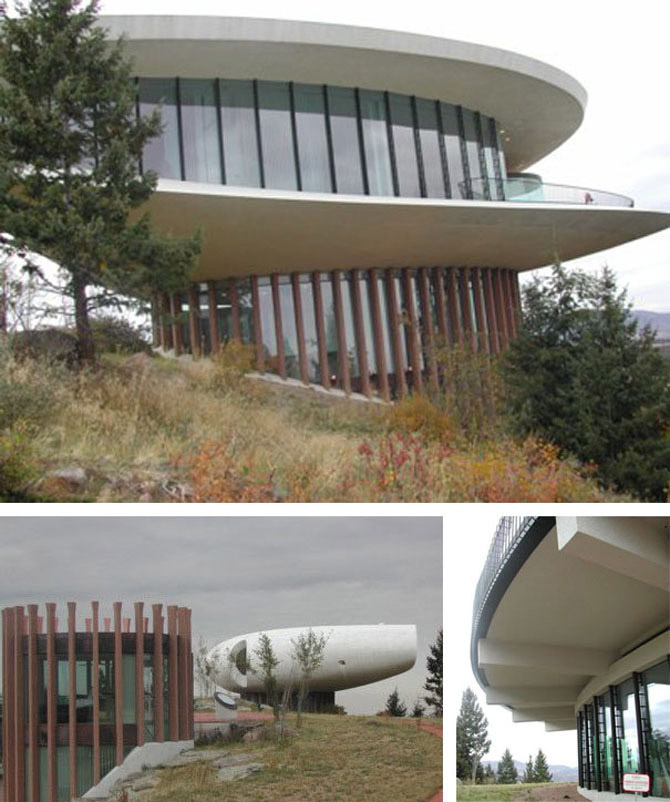
77. Nautilus (Nautilus House). Mexico City, Mexico.
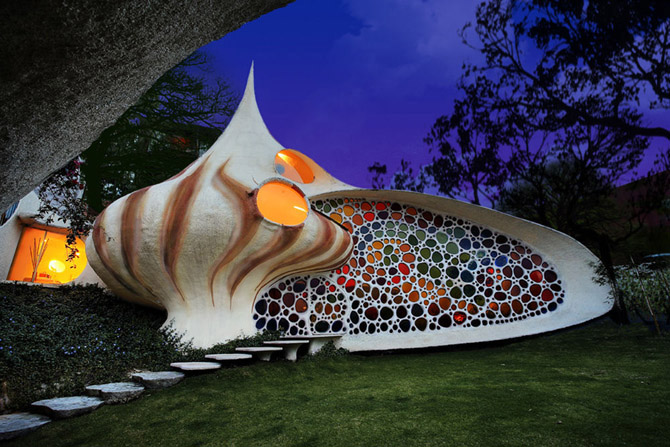
78. Igloo (Eskimo hut made of hardened snow). Kvivik, Faroe Islands.
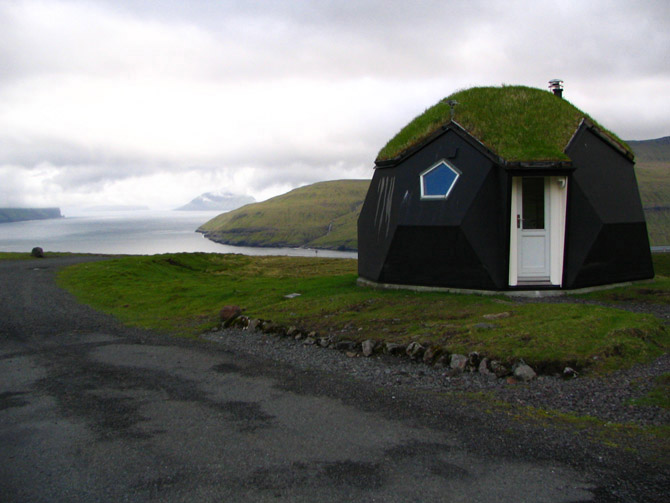
79. Modern igloos. Alaska.
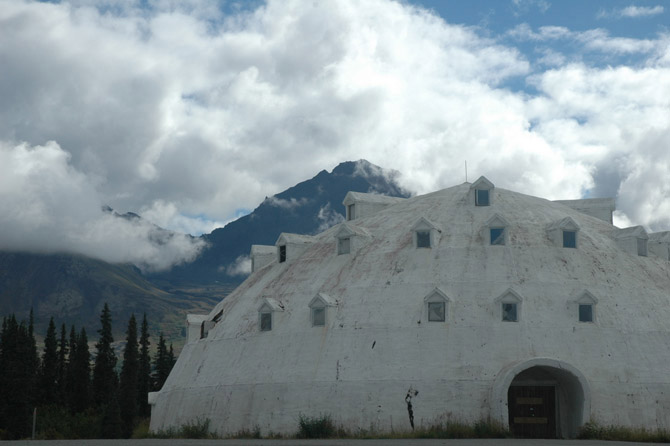
80. Atomium. Brussels, Belgium.
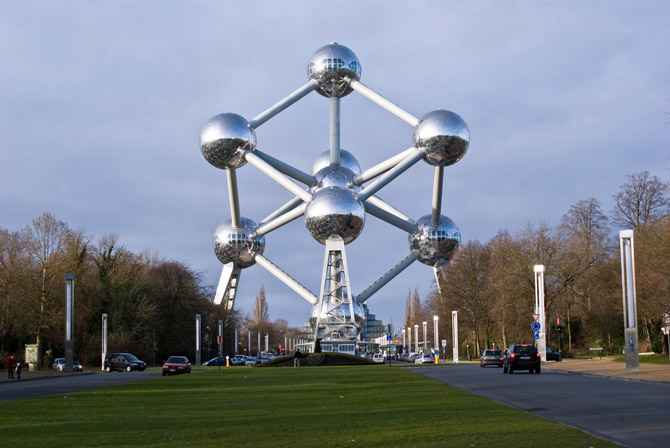
81. Cathedral of Brasilia. Brazil.
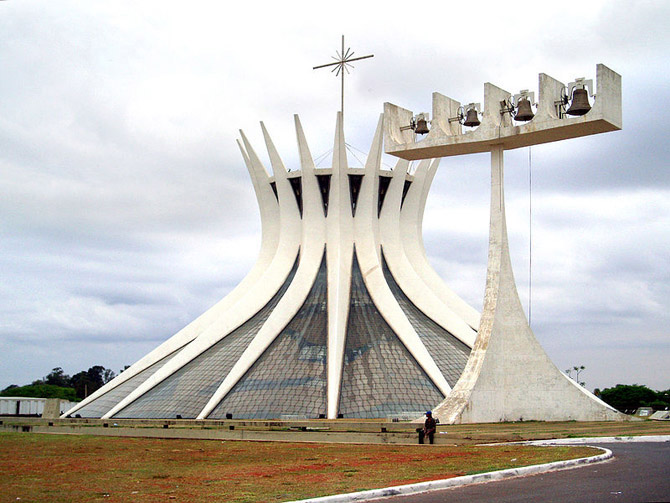
82. Building-arch (Great arche of defense). Paris, France.
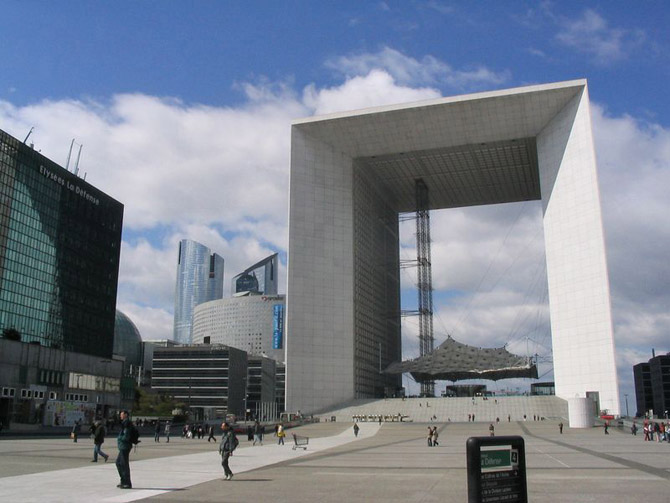
83. Quarry house (La Pedrera). Barcelona, Spain.
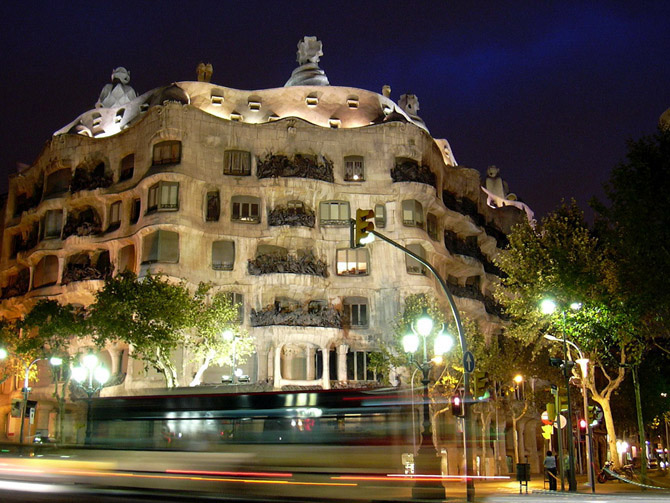
84. "Broken" house (Errante Guest House). Chile.
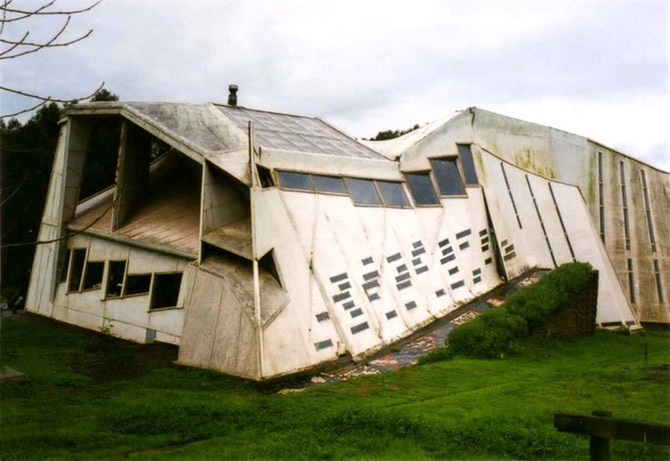
85. Museum of Contemporary Art (Museum of Modern and Contemporary Art). Nice, France.
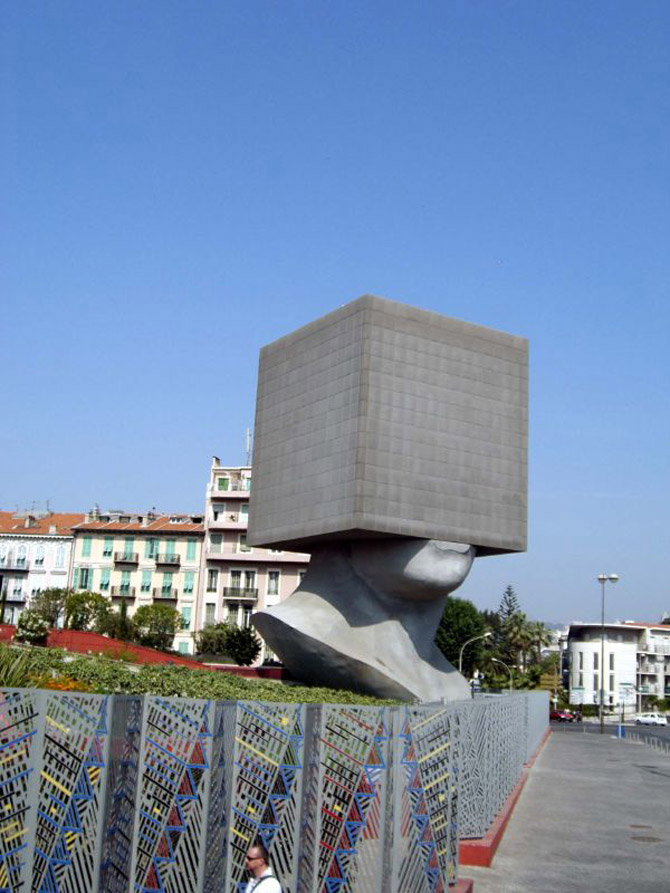
86. Agbar Tower. Barcelona, Spain.
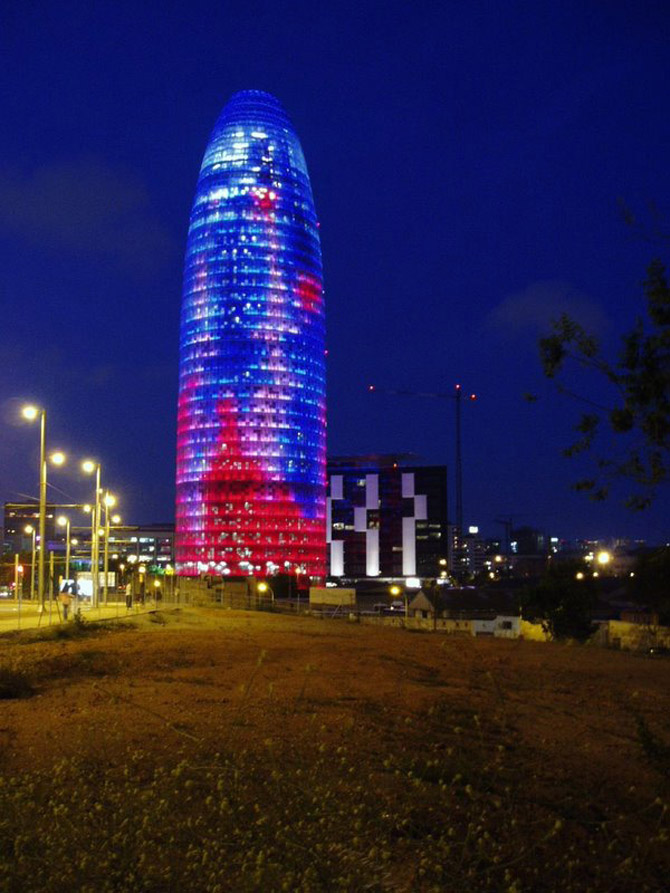
87. Museum of entertainment (The Museum of Play). Rochester, USA.
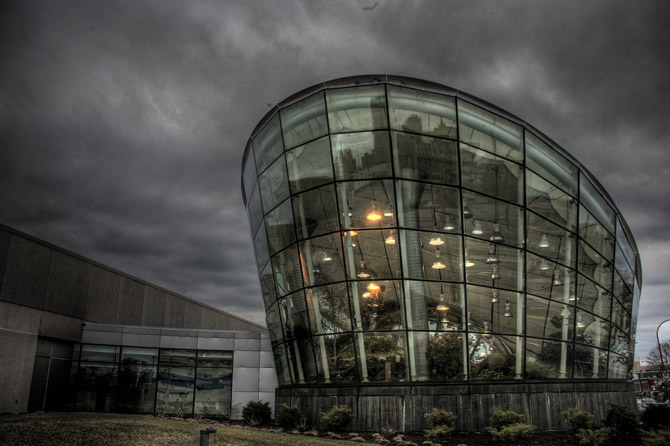
88. House-bubbles (Bubble House). Bay Aria, California, USA.
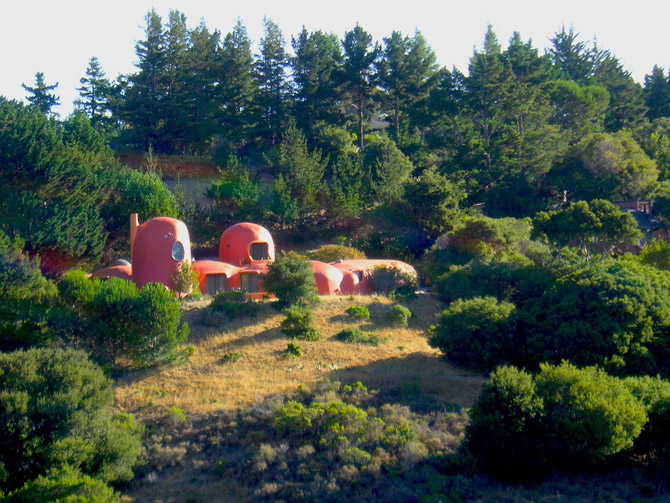
89. Pyramid (Raffles Dubai in Wafi city). Dubai, UAE.
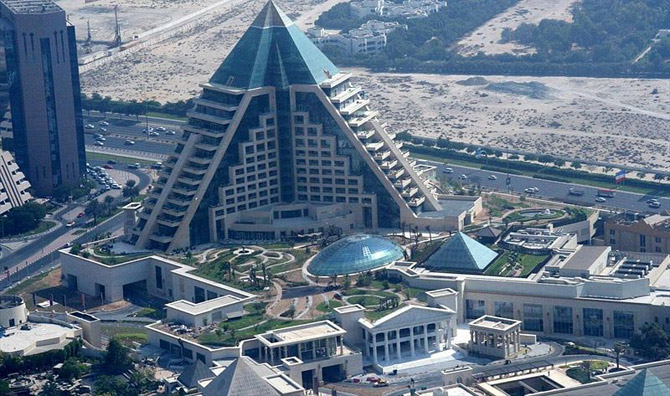
90. "Atlantis" (Atlantis). Dubai, UAE.
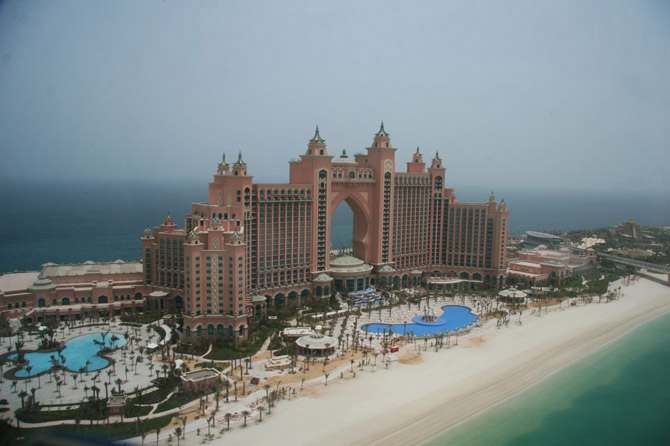
91. House of Music (Casa da musica). Porto, Portugal.
![]()
92. Carl Zeiss Planetarium. Berlin, Germany.
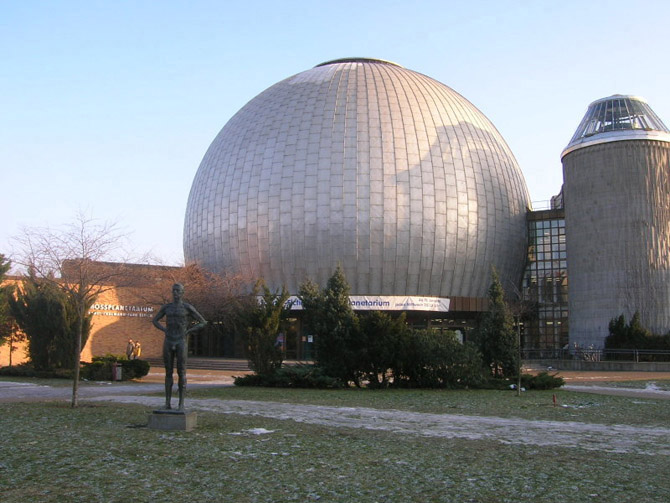
93. National Theater (National Theatre). Beijing, China.
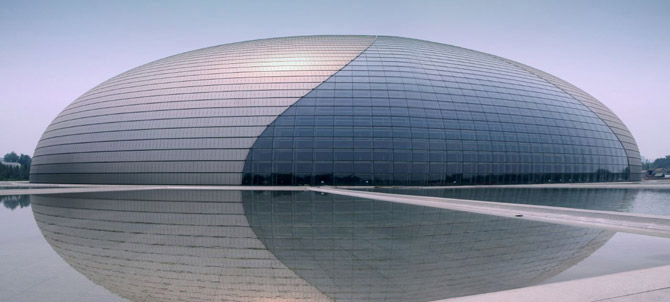
94. Montreal Biosphere (Montreal Biosphère). Canada.
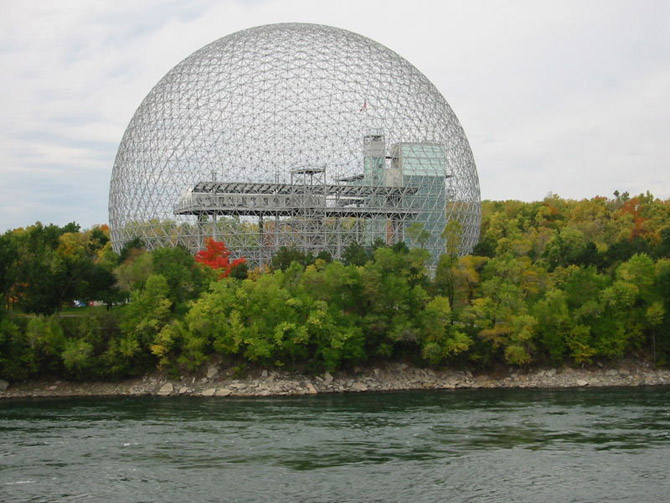
95. Project "Eden". Great Britain.
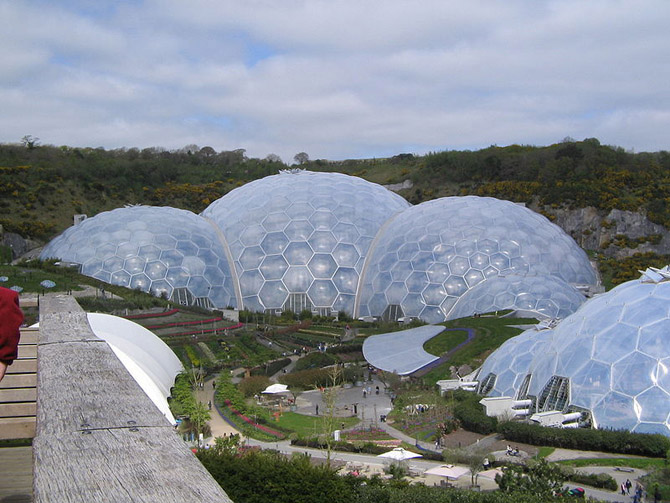
96. Kobe Port Tower Japan.
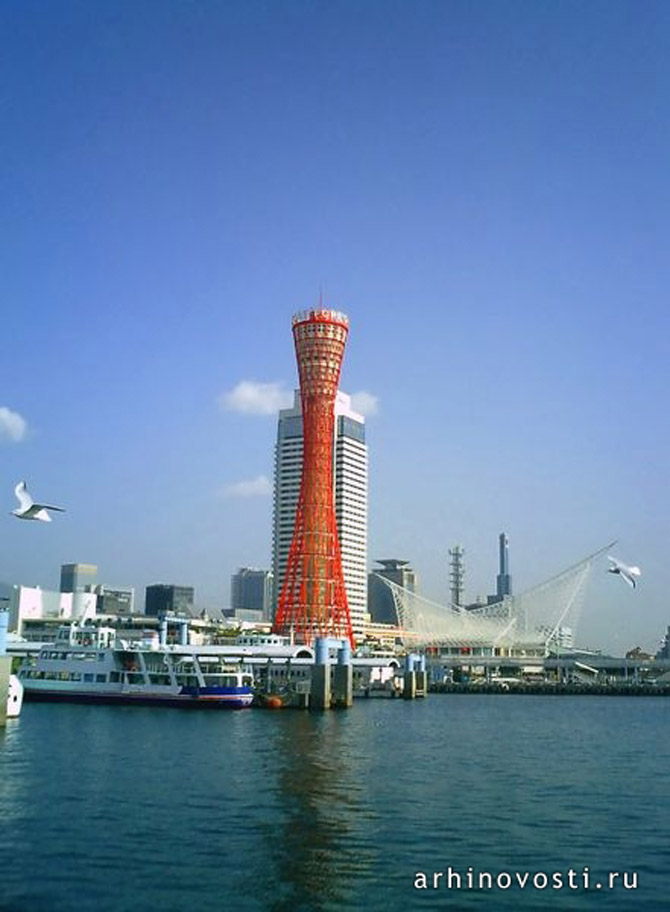
97. Egg. Mumbai, India.
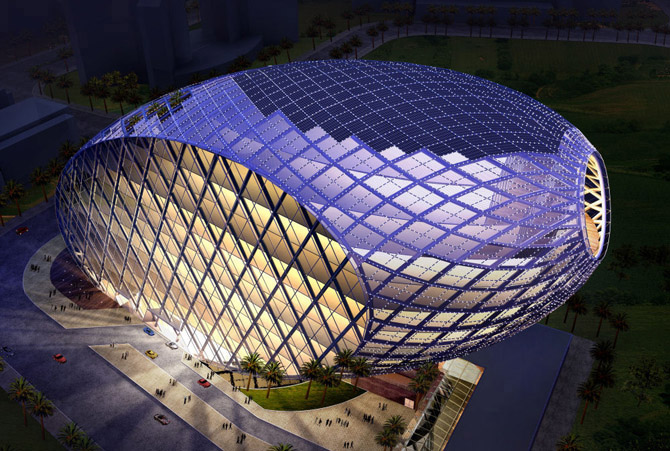
98. Kunsthaus, House of Arts (Kunsthaus). Graz, Austria.
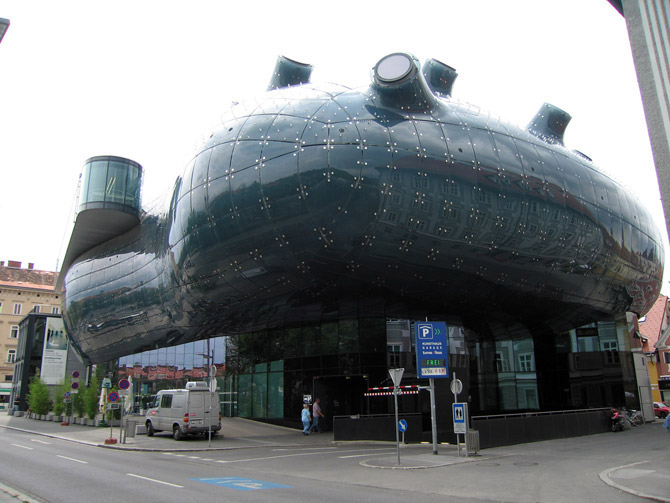
99. Federation Square Melbourne, Australia.




